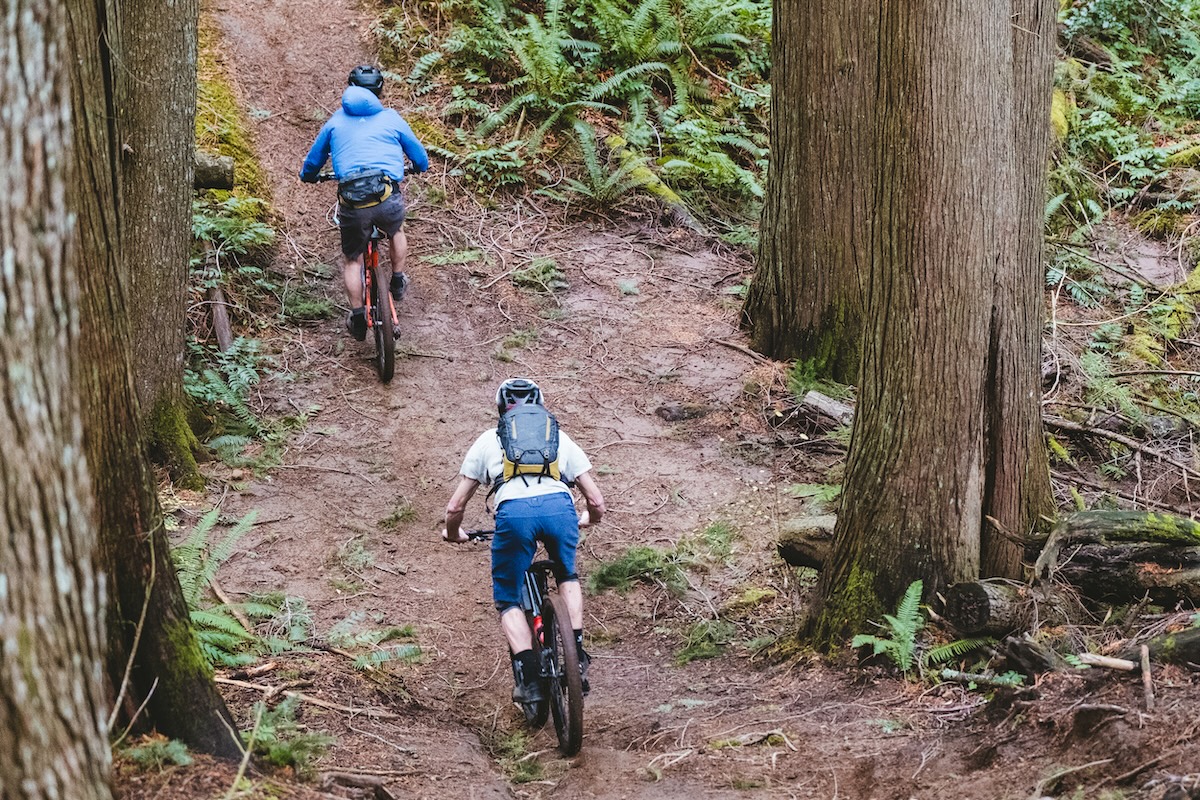
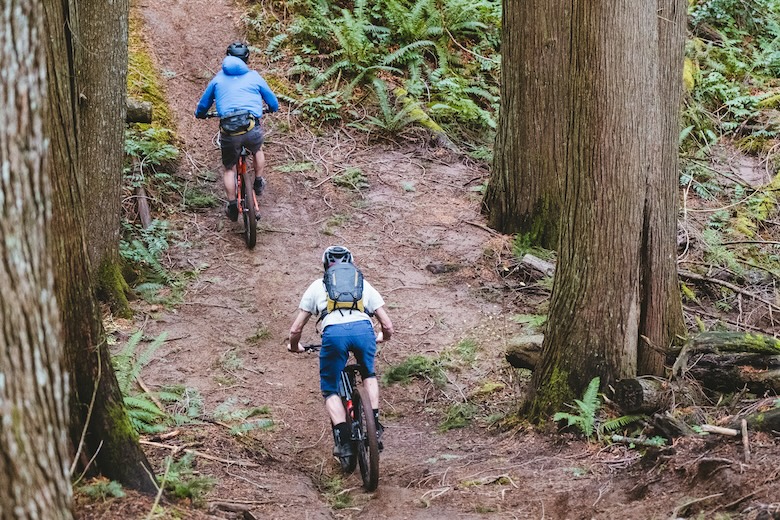
Mountain biking can take on many forms, from hot laps on the backyard trail to long, winding singletrack through the alpine. Regardless of the riding style you gravitate toward, nearly every trip out requires you to carry water, snacks, tools, and other gear. The most common carry method is a mountain bike backpack, but we've also included a few waist packs on our list below. Designs vary pretty widely, and important considerations include carrying comfort, interior volume, water-hauling capacity, and pockets and organization. For more background information, see our comparison table, buying advice, and testing process details below the picks.
Editor's note: We updated this guide on September 16, 2025, to move the Evoc Hydro Pro Hydration 3 up as our favorite vest for mountain biking. We also added a number of new packs, including Osprey's Savu 5, USWE's MTB Hydro 3L, POC's Column VPD Backpack Vest, and High Above's Lookout 2.7L. Lastly, we refined our list by removing a few packs that no longer stood out in terms of performance.
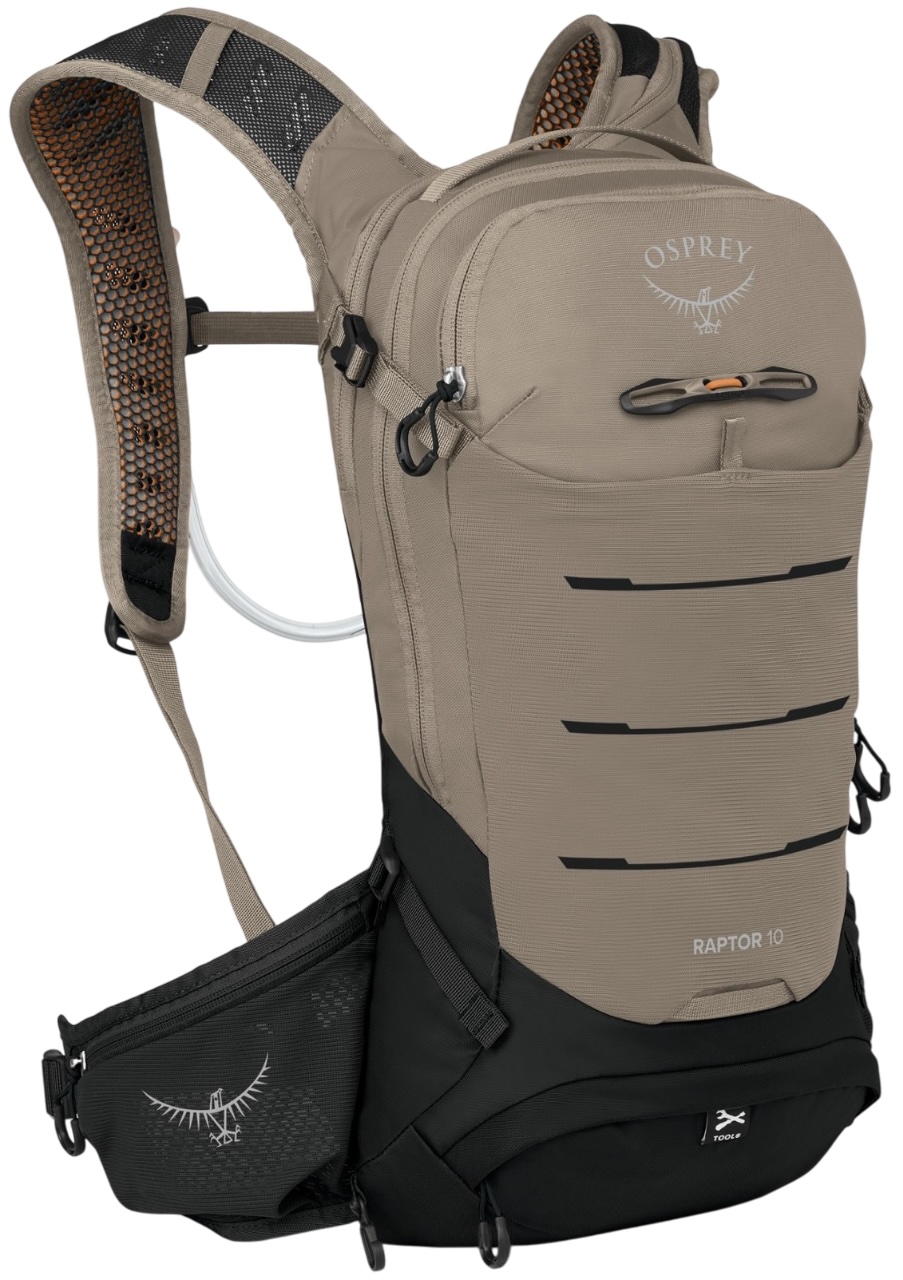 Capacities: 10, 14L
Capacities: 10, 14L
Weight: 1 lb. 11.8 oz.
Reservoir included: Yes (2.5L)
What we like: Comfortable and versatile with top-notch organizational features.
What we don’t: Pretty pricey; stretchy mesh exterior seems prone to damage.
With a versatile, do-everything design and plenty of practical features, Osprey’s Raptor 10 and women’s-specific Raven 10 earn our top spot. We’ve tested multiple variations of the pack over the years, and its all-rounder nature and premium build continue to impress: The Raptor’s 10-liter capacity is spacious enough to fit extra layers, lunch, pads, and a small bike pump for longer rides, but it’s equally easy to compress it for quick lunch laps. For organizing gear, the pocket layout is extremely well sorted with a grand total of 10 zippered and stretch pockets, including a dedicated space for tools with a built-in roll pouch at the base. Carrying comfort is another highlight, and in the techy stuff and during all-day efforts, the wide shoulder straps—Osprey dubs them their “winged” harness—nicely distribute weight and give it a well-balanced feel. Tack on a quality 2.5-liter Hydraulics LT reservoir, best-in-class helmet carry, and burly 210-denier (D) nylon construction, and the Osprey was our runaway favorite.
No pack is perfect, however, and we have just a few concerns with the Raptor and Raven. In testing the latest version, we were a bit concerned with the durability of the stretchy mesh fabrics on the hipbelt and exterior dump pocket. While we don’t have any specific issues to report, the fabric does seem prone to snagging and wear if not handled carefully. And while we’re otherwise big fans of the helmet carry system, it’s worth noting that it’s not compatible with full-face helmets (the 14-liter version is full-face helmet compatible, if that's a priority for you). Lastly, we found the Raptor a bit large for most missions. A smaller waist pack or vest is a lighter weight (and generally less expensive) option for shorter days. But if you’re on the hunt for something that will keep up with demanding full-day rides, the Raptor and Rave are truly hard to beat.
Read more: Osprey Raptor 10 review
See the Men's Osprey Raptor 10 See the Women's Osprey Raven 10
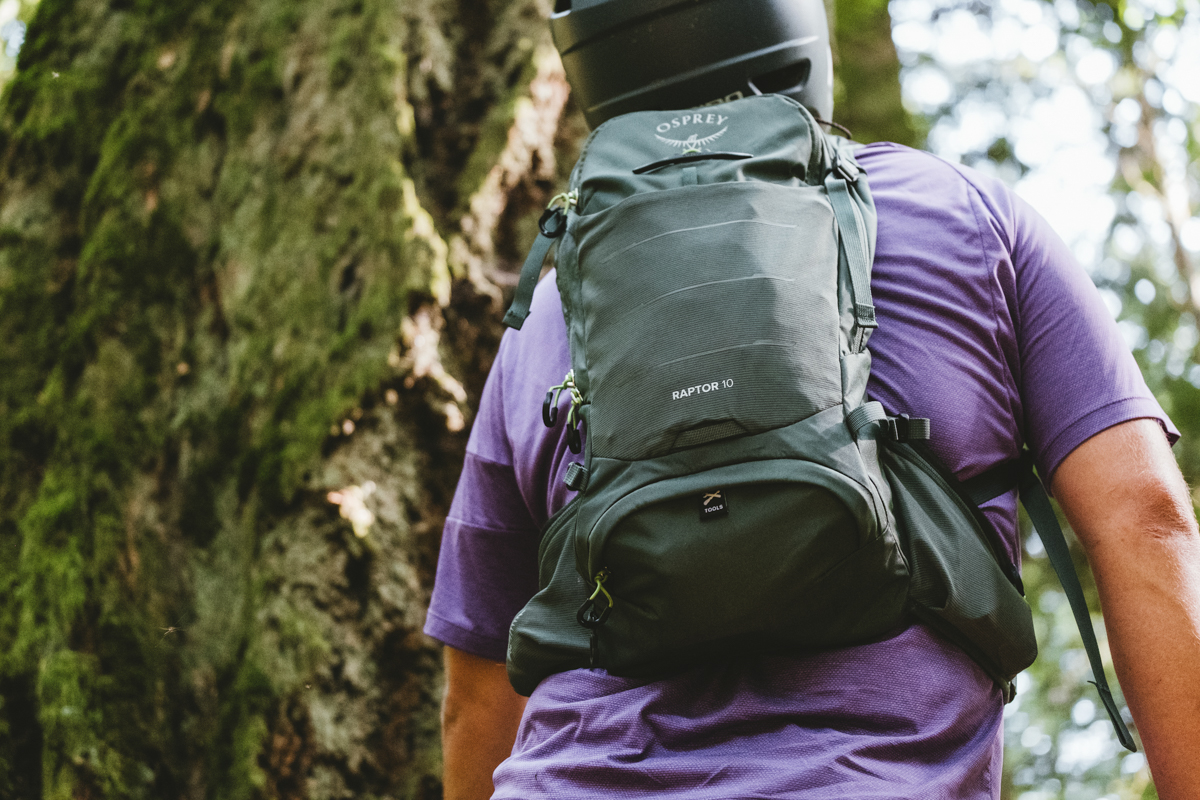
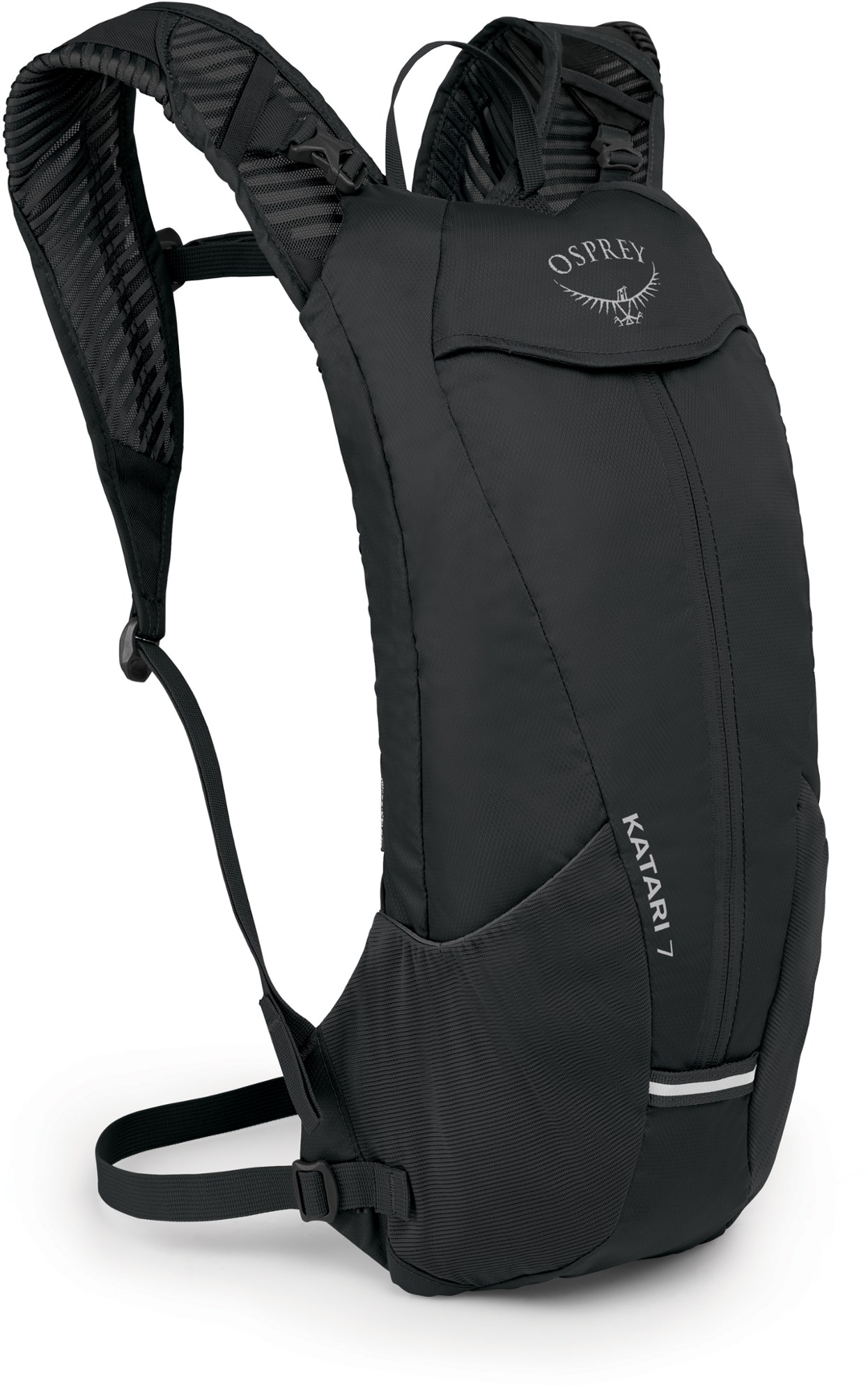 Capacities: 1.5, 3, 7L
Capacities: 1.5, 3, 7L
Reservoir included: Yes (2.5L)
Weight: 1 lb. 3.8 oz.
What we like: Competitively priced, no-frills design.
What we don’t: Lack of structure concentrates weight on the shoulders rather than the hips.
Osprey is a leader in the pack market, so it comes as little surprise that our top two designs this season are from the venerable Colorado brand. Despite being the cheapest backpack on our list at $90, it's not all cost-cutting with their Katari and women's Kitsuma: Even with its essentials-only design, the Katari can carry a bunch of water (it comes with the same 2.5L Hydraulics LT reservoir as our top pick), is offered in three capacities (1.5, 3, and 7L), and features functional stretch side pockets for small items you want easy access to. For riders who need a lot of water but not much else—think multi-hour rides in hot or desert-like regions—the concept makes a whole lot of sense.
Unfortunately, the Katari has a few notable faults. Most significantly, all our testers complained that the pack puts essentially all the weight on your shoulders. Combined with a minimalist backpanel that prioritizes ventilation over structure, the pack felt floppy and bounced around far more than expected for such a lightweight design. And while we like the concept of the vertical main compartment zipper (similar to that of the Patagonia Dirt Roamer below), the Osprey only has one zipper, so you can’t strategically open certain portions of the pack and will need to be mindful to prevent items from spilling out. But for minimalists and those just starting out, it's nevertheless hard to beat the value of the Katari, earning it our vote as the best budget design this season.
See the Men's Osprey Katari 7 See the Women's Osprey Kitsuma 7
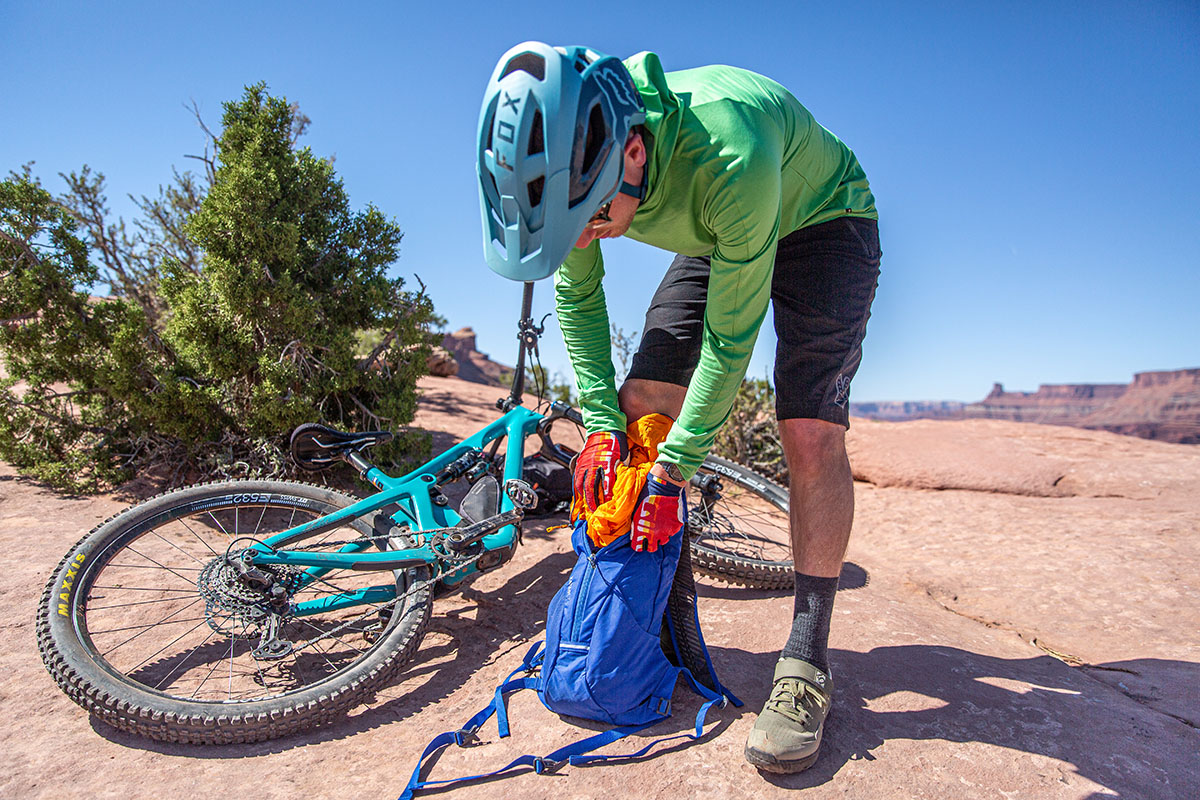
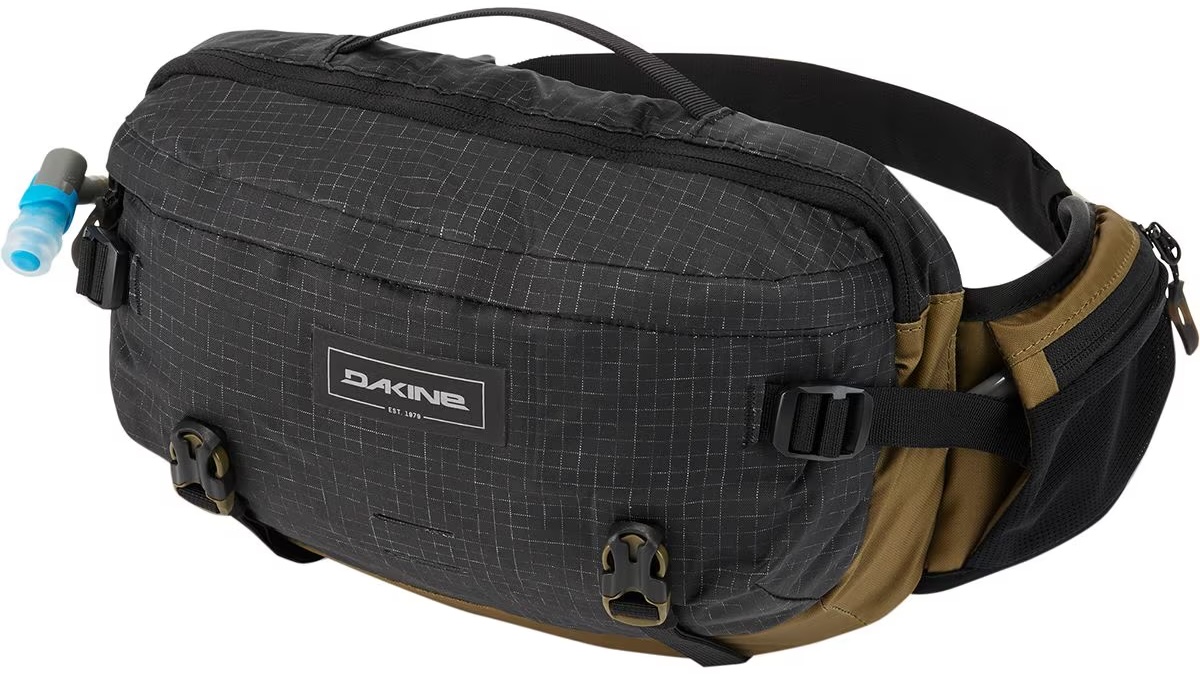 Capacity: 6L
Capacity: 6L
Reservoir included: Yes (2L)
Weight: 13 oz.
What we like: Well-sorted storage layout for short rides; very comfortable and supportive.
What we don’t: Pricey for the capacity; waist packs have some inherent drawbacks.
Fanny packs have made quite the comeback in recent years, and they’ve become especially popular in the mountain biking space. With the ability to carry everything you need and nothing you don’t, these minimalist companions are a great choice for lunch laps and short rides that don't require a ton of water or gear. Our favorite in this category is Dakine's Seeker 6L. Despite its unassuming size, the Seeker boasts a plethora of internal storage, two hipbelt pockets, and external compression straps to accommodate varying load sizes. You even get a quality 2-liter HydraPak reservoir that stores seamlessly along the hipbelt. And while we’ve ridden with our fair share of unwieldy hip packs, we found the Seeker 6L to be very comfortable and supportive for our lower back (the firm backpanel is forgiving for haphazard packing, as well). To top it all off, all of the details—including the zipper, buckles, and straps—are high-quality, as is the beefy (450D) ripstop exterior.
However, not all riders will love the fanny pack design—in addition to polarizing looks, waist packs have a very different feel compared to standard backpacks due to differences in weight distribution. Some will also find it tough to justify the price tag, considering the limited capacity (for a cheaper waist pack, check out the Osprey Savu below). Plus, you lose out on a helmet carry system by going the hip pack route. Finally, while we have very few performance gripes, the Seeker's reservoir takes up a good amount of space when full, which further limits the pack's capacity. But again, most of these downsides are inherent to waist packs in general, and we think Dakine landed on a real winner with the Seeker 6L.
See the Dakine Seeker 6L
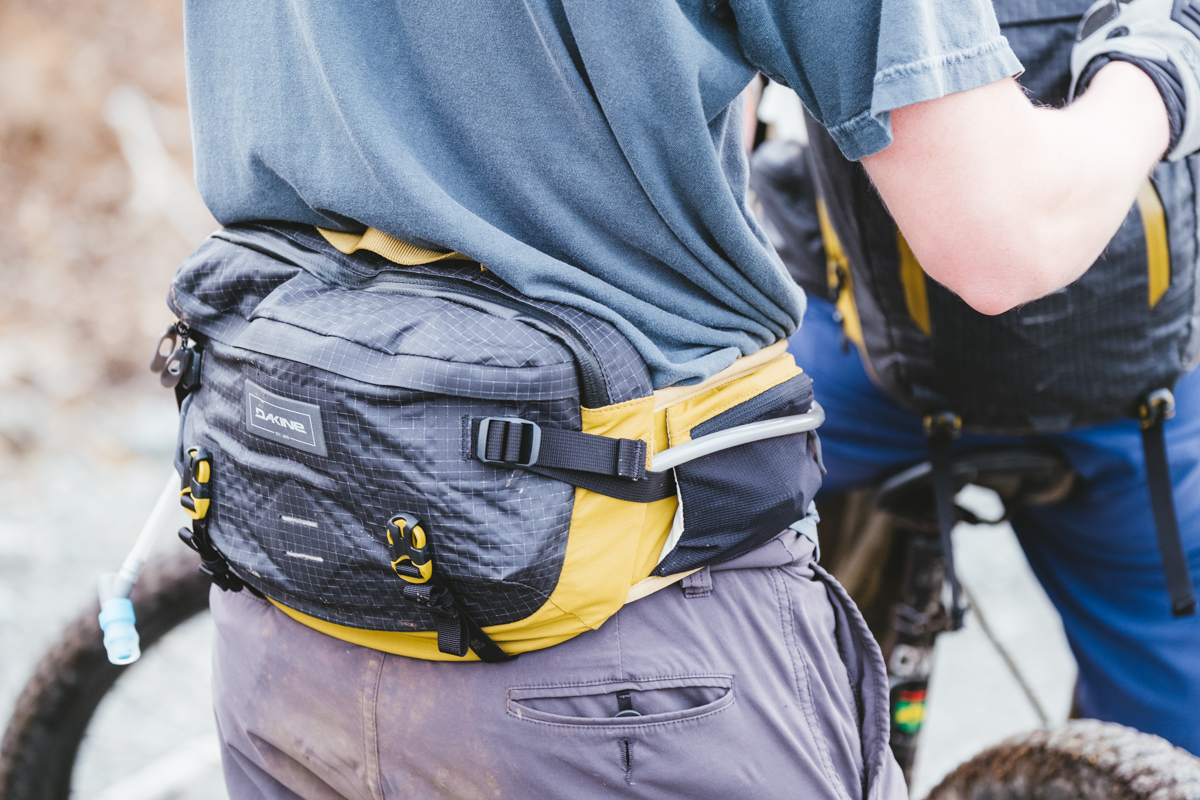
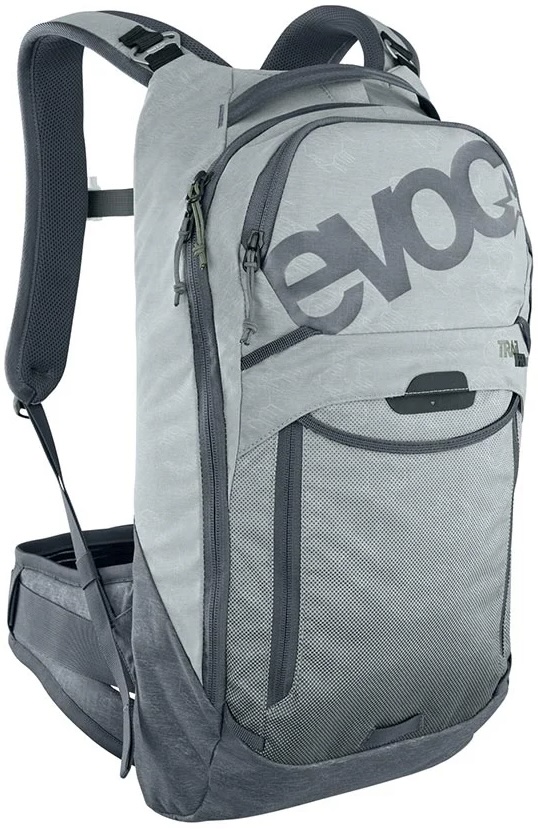 Capacities: 10, 16, 26L
Capacities: 10, 16, 26L
Weight: 1 lb. 15.7 oz. (size S/M)
Reservoir included: No
What we like: A high-quality and comfortable pack with built-in spine protection.
What we don’t: Expensive and doesn’t come with a water reservoir.
If you gravitate toward steep and rugged descents or have a propensity for gap jumps, exposed skinnies, and other features that push the risk-to-reward ratio, a pack with integrated spine protection is worth considering. Within this category, we love the Evoc Trail Pro, which is snug and balanced on the roughest trails and boasts the brand’s Liteshield Plus back protector—a built-in pad engineered to absorb shock and prevent the spine from overextending in the event of a crash. On top of the helpful safety feature, the Trail Pro boasts the best hipbelt of any pack we tried: It’s supremely comfortable even when pulled snug, and stretchy Velcro straps that sit under the buckle reduce pressure and friction around the navel. And unlike many options here, the Trail Pro’s hipbelt pockets are large and easily accessible—great for on-the-go snacking and keeping your phone handy. A final bonus: The Trail Pro is offered in two sizes for dialing in a more precise fit, which is a rarity in the market.
We strongly considered the Evoc Trail Pro 10 as our top all-around pick—it’s that good. However, its high price makes it a hard sell for many riders, especially considering you’ll have to purchase a water bladder separately. In addition, those who aren’t pushing the limits in terms of terrain, air time, and/or speed will likely find the back protection superfluous. Another small complaint we had is that the spine protector negatively impacts breathability, so the Evoc lands on the warmer end of the spectrum (it’s noticeably hotter than standard designs like the Osprey Raptor or CamelBak Mule Pro below, although the panel can be removed). Lastly, if you're looking for a smaller pack with back protection, check out POC's Column VPD Backpack Vest below, which has 8 liters of capacity and vest-like features such as pockets along the shoulder straps.
See the Evoc Trail Pro 10
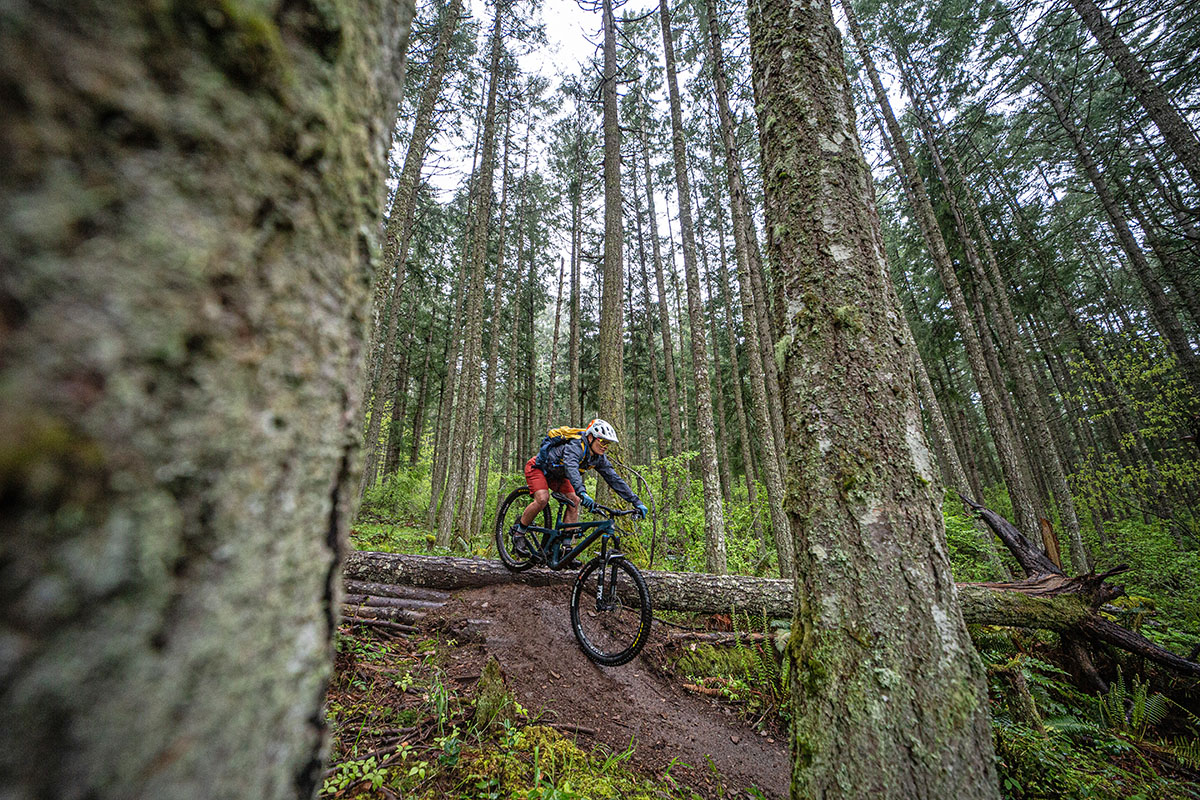
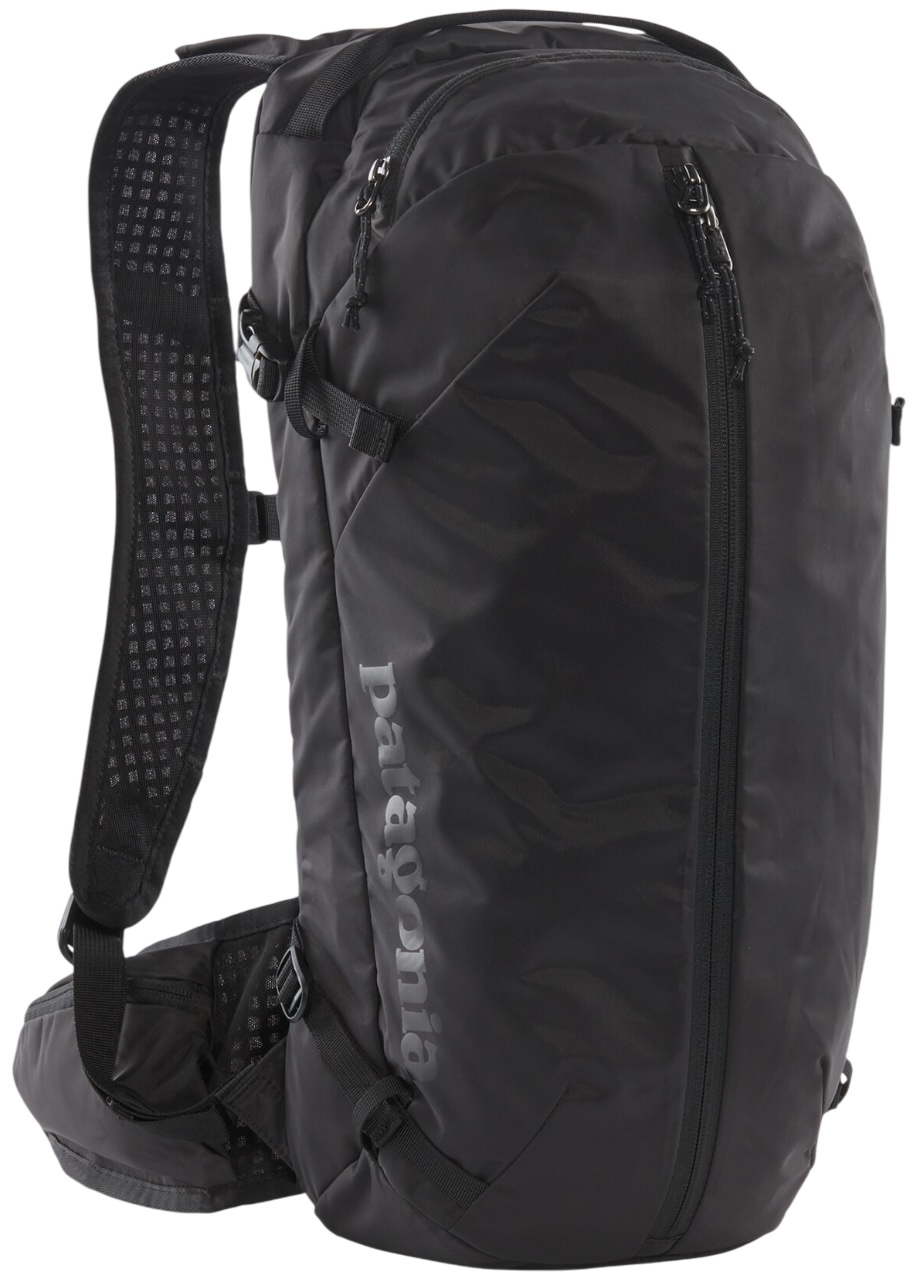 Capacity: 20L
Capacity: 20L
Reservoir included: Yes (2L)
Weight: 1 lb. 8.0 oz.
What we like: A comfortable and light high-volume pack for longer rides.
What we don’t: Poor back ventilation.
Patagonia entered the mountain bike gear arena a few years back with their flagship Dirt Roamer series (jackets, pants, etc.), with hydration packs being a fairly recent addition to the line. The Dirt Roamer 20L here stands out as a high-volume pack that sticks to Patagonia’s ethos with a sustainable and streamlined design. The pack has a generous main compartment that’s accessed with vertically oriented zippers (we appreciate that it has two zippers for opening small sections at a time) and a separate side-access sleeve for the water reservoir. And although the design is relatively simplistic, it doesn’t skimp on organization with internal elastic loops and small pockets for separating gear. Whether you’re headed out on an all-day ride or shuttling in camera gear for the perfect photo op, the Dirt Roamer is well equipped for the job.
Sweaty backs are part of the mountain bike experience, but we found that the Patagonia fell short of alternatives like Dakine's Seeker 18L and Drafter 10L below in terms of ventilation. Even though it boasts a mesh backpanel, we were quick to heat up and often found salt deposits from sweat on the rear of the pack. Additionally, we noticed more movement and bounce than expected off jumps and drops despite the four-compression-strap layout. To be fair, some level of movement is to be expected given the capacity, and the wide, oversized waistbelt helped with stabilization. In the end, the Dirt Roamer 20 is too much pack for many riders, but its high-capacity shape and creative zipper design make it a quality option for gear-intensive adventures.
See the Patagonia Dirt Roamer 20L
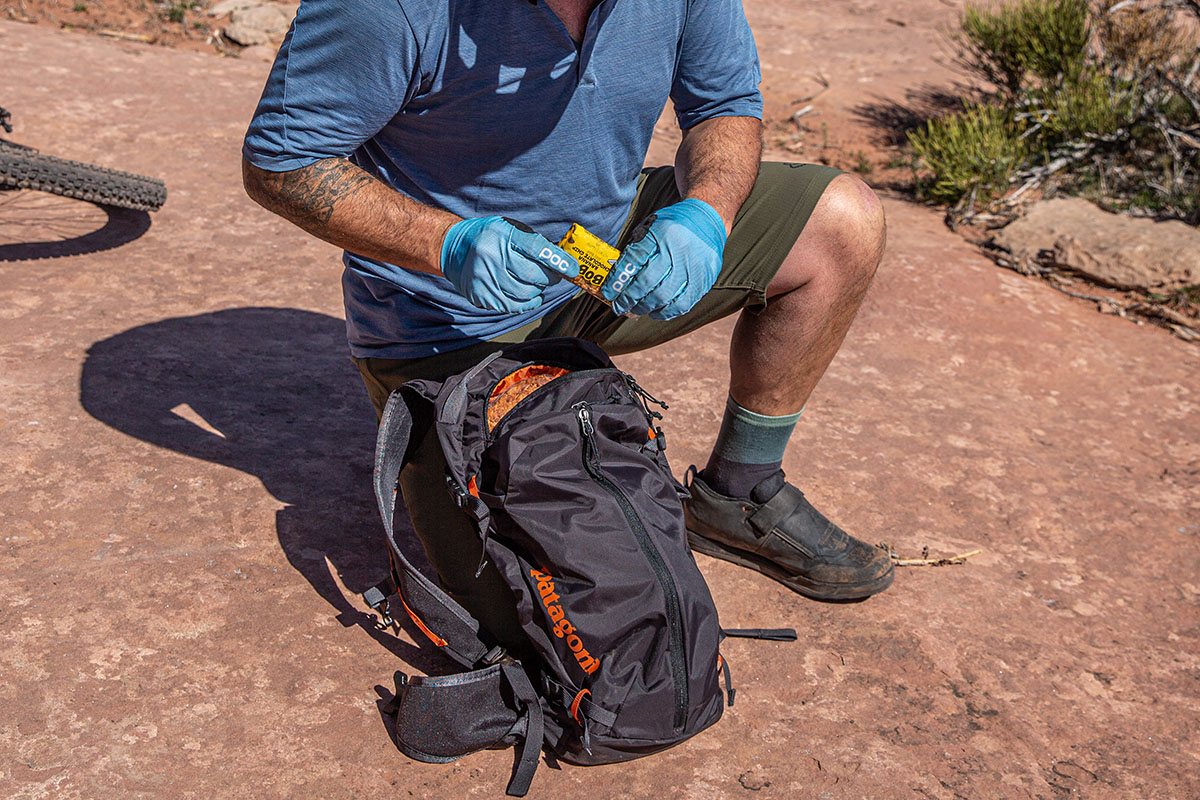
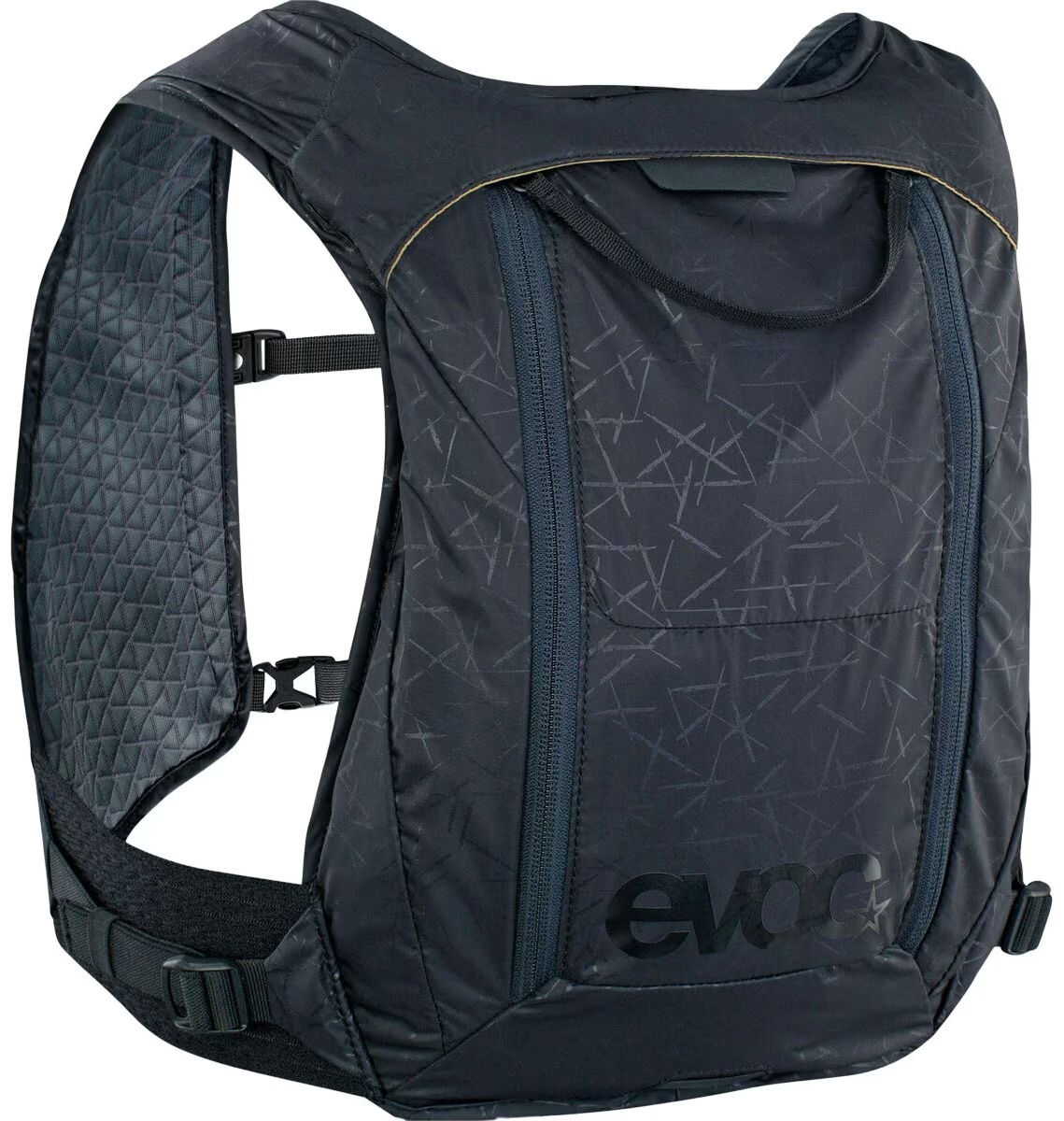 Capacities: 1.5, 3, 6L
Capacities: 1.5, 3, 6L
Reservoir included: Yes (1.5L)
Weight: 8.8 oz.
What we like: Running vest-inspired design is low-profile and offers easy on-the-go access.
What we don’t: A standard running vest will serve the same purpose and potentially offer better storage.
Evoc’s Hydro Pro 3 features a thoughtful blend of running vest-like carrying comfort and organization with a cycling-specific feature set. The main compartment of the pack provides enough space for tools, snacks, and a light layer, while the zippered and mesh pockets on the shoulder straps are convenient for divvying up items like gels, soft flasks (sold separately), and car keys. And as we've come to expect from Evoc, all of the materials and components have a premium feel, including breathable mesh, quality buckles, and smooth-operating zippers. For riders looking for a close, body-hugging fit and easy on-the-go access, there's a lot to like about the Hydro Pro 3.
However, as with any crossover design, the Evoc Hydro Pro makes some concessions in the name of versatility. Our tester cleverly pointed out that a true running vest could serve the same purpose while offering benefits in organization (we weren’t able to fit our phone in either of the mesh shoulder pockets). In fact, the Hydro Pro is only $5 cheaper than our top-rated running hydration vest, the Salomon ADV Skin 5 Set, which features a more thoughtful pocket layout and 2 liters of additional capacity. The Evoc does have the benefit of tool-specific storage inside the zippered shoulder strap pockets, but most running vests will be able to accommodate tools without issue. In the end, we'd break it down as follows: If you only plan to use this pack for mountain biking, it's worth considering; if you're primarily a runner and already own a running vest, there's little reason to invest in the Evoc—we'd instead point you to a standard mountain bike pack or waist pack if you want to have multiple options in your quiver.
See the Evoc Hydro Pro 3
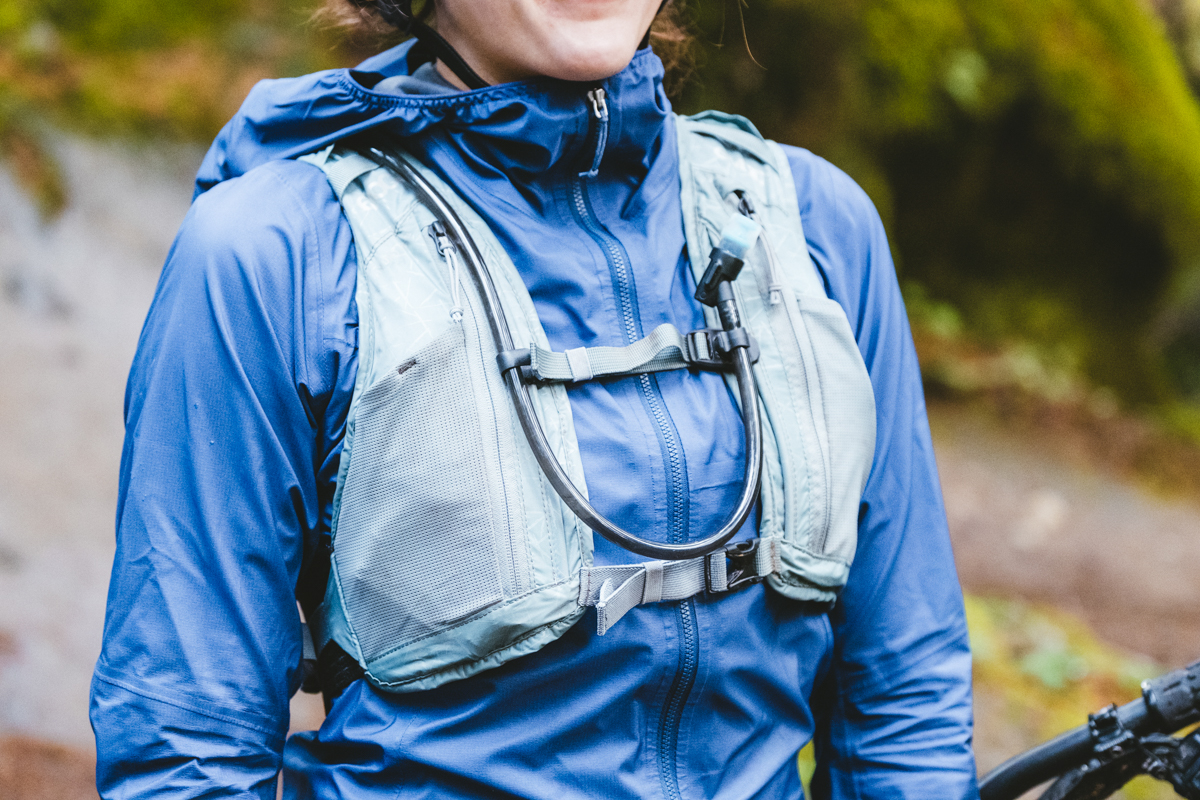
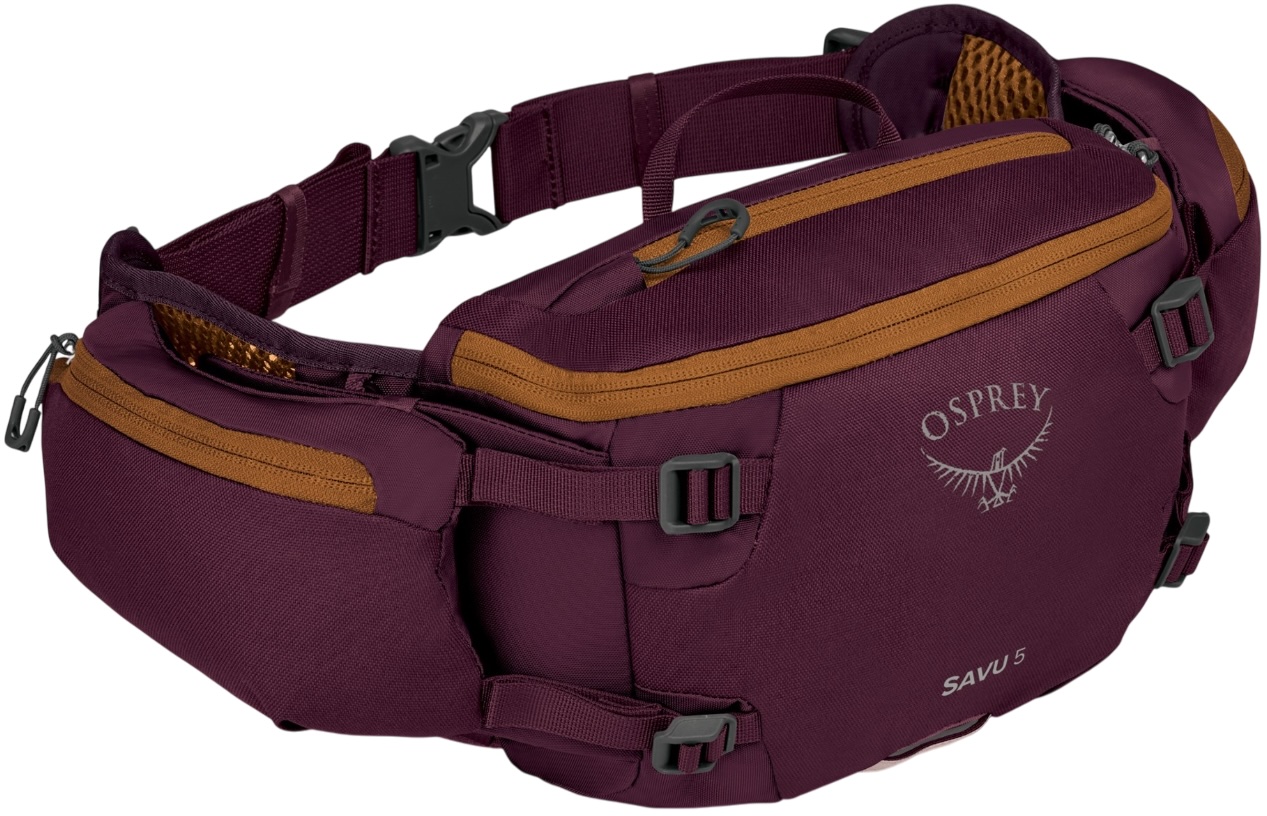 Capacities: 2, 5L
Capacities: 2, 5L
Reservoir included: No
Weight: 13.3 oz.
What we like: A comfortable, breathable, and affordably priced hip pack with functional storage.
What we don’t: Not reservoir compatible; bottles can be hard to access on the go.
The Dakine Seeker 6L above is no small investment, but Osprey offers a budget-friendlier alternative in their Savu 5 here. Though you do lose 1 liter of capacity in opting for the Savu, we found the storage layout to be entirely functional for short rides: While the pack forgoes a hydration reservoir, it does include two side water bottle pockets that, thanks to two shock cords, don't have a heavy impact on weight distribution. The lack of bladder leaves the interior wide open, and we were easily able to divvy up snacks, bike tools, a windbreaker jacket, and personal essentials without issue. What’s more, Osprey’s Airscape backpanel offers best-in-class breathability and comfort, and the impressively thick 600D outer fabric and PFAS-free durable water repellent (DWR) puts up an admirable defense against tire spray and rough use.
There are some inherent downsides to opting for the Savu over the Seeker 6L above. Most notably, we found the Savu’s water bottle carry to be a bit less intuitive than a reservoir: The bottles are tougher to access on the go, especially since the shock cords are tricky to loosen with just one hand. The Savu also doesn’t come with water bottles, so you’ll have to shell out for a couple if you don’t already have any handy. If you prefer a reservoir, Osprey’s Seral 7 features a nearly identical design to the Savu—including the Airscape backpanel—but comes with a 1.5-liter Hydraulics reservoir. Unsurprisingly, the Seral 7 is costlier than the Savu, but it still undercuts the Seeker 6L by a decent margin (though we prefer the Seeker's sleeker hose carry and larger reservoir). Lastly, if you're looking for another cheap option, check out CamelBak's Podium Flow 4, which comes with a water bottle upon purchase.
See the Osprey Savu 5
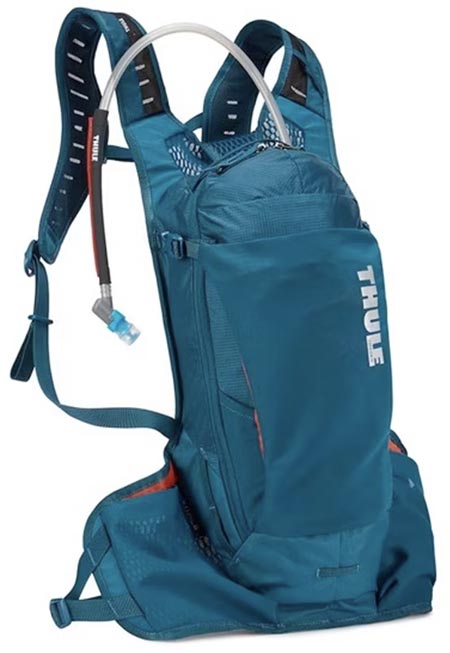 Capacities: 3, 6, 8L
Capacities: 3, 6, 8L
Reservoir included: Yes (2.5L)
Weight: 1 lb. 3.4 oz.
What we like: Slick magnetic hose attachment system and nice pocket layout.
What we don’t: No helmet carry option; we’d prefer a higher-capacity model.
Thule likely isn’t the first brand that comes to mind for backpacks, but we’ve been impressed with the quality of their hiking, travel, and MTB collections. The Vital 8L here stands out in one key way: its secure and extremely practical hose attachment system. Rather than the button-sized magnets or plastic hooks used on other designs, Thule utilizes a strip of magnets (about 5 in. in length) along the right-hand shoulder strap to keep the hose in place while riding. You simply pull the nozzle as usual to drink and then release, and the hose reconnects to the strap automatically. It’s an elegant and very secure solution that we found works flawlessly.
For the rest of the pack, the Vital stacks up pretty well to big hitters from Osprey, CamelBak, and Dakine. Organization is good overall—we especially liked the mesh pockets right at the hips that are well sized for snacks and easy to access without having to remove the pack. And the Vital carries weight relatively low, which keeps it solidly in place even during steep and technical descents. At 8 liters for the biggest size, the Thule likely won’t do the trick for most full-day efforts or times of year when you need extra layers. Additionally, Thule omitted a helmet carry, which could be a dealbreaker for some. Overall, it’s not a home run and is a little less of an all-rounder than our top picks, but the smart hose solution and excellent all-around build quality make it a good offering nonetheless. Note: At the time of publishing, the women’s specific version is low on stock, though we have found a few still available on Amazon.
Read more: Thule Vital 8L review
See the Men's Thule Vital 8L See the Women's Thule Vital 8L
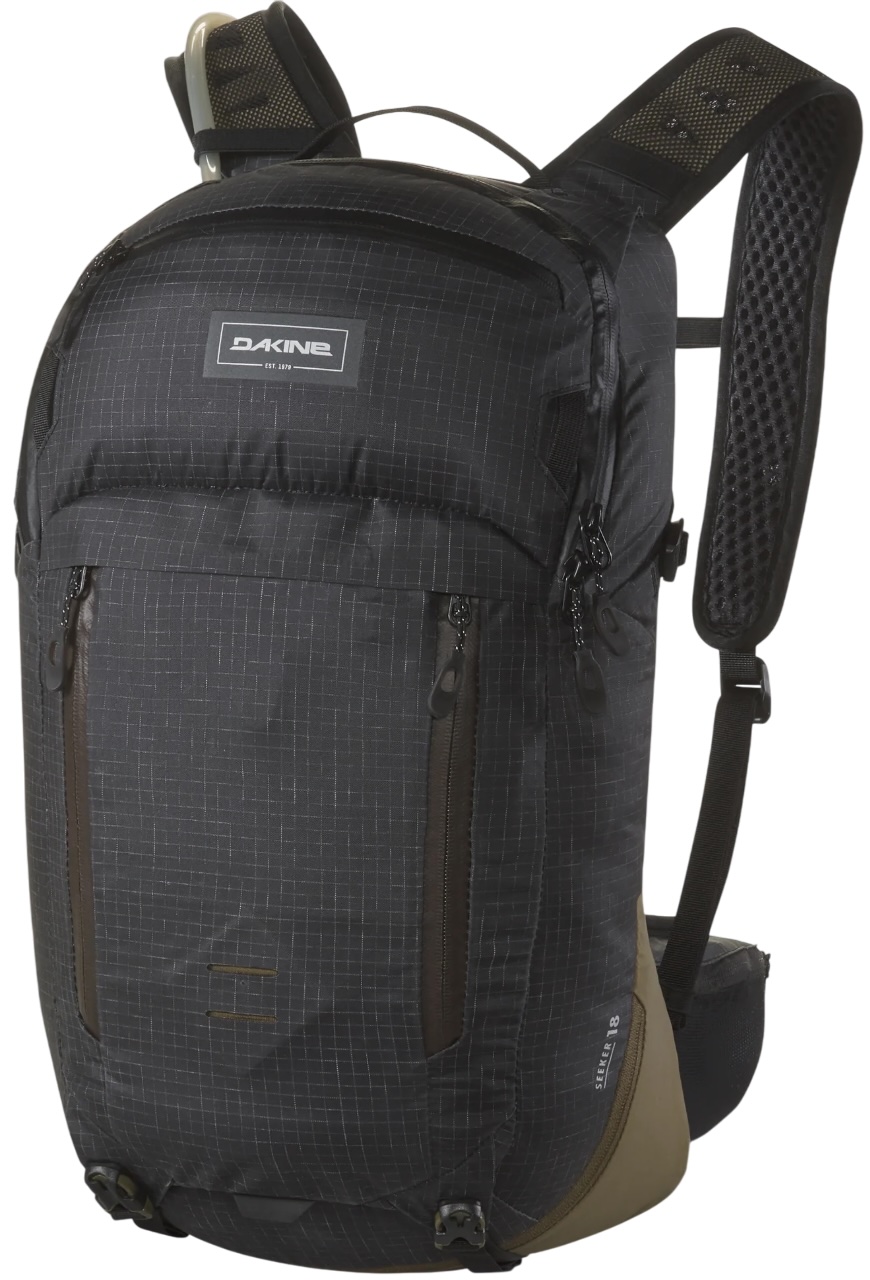 Capacities: 10, 18L
Capacities: 10, 18L
Reservoir included: Yes (3L)
Weight: 1 lb. 15.8 oz.
What we like: A high-capacity pack with more features and better breathability than the Dirt Roamer above.
What we don’t: Heavier and pricier than the Dirt Roamer; some may have issues with the fit.
Patagonia's 20-liter Dirt Roamer above is our favorite high-capacity pack for long and gear-intensive adventures, but Dakine's Seeker 18L is another excellent option to have on your radar. The Seeker's headlining feature is its suspended mesh backpanel, which offers excellent airflow by keeping the pack farther off your back. The rest of the design is thoughtfully executed, too, including a practical storage layout, comfortable straps, and good adjustability. We especially like the location of the 3-liter hydration bladder, which is positioned at the bottom of the pack to keep your center of mass low (bonus: It doubles as a space to stash dirty or wet clothes). And for those who like to get out year-round, the Dakine is up to the task with a robust, weather-ready build that will stand up to significant use and abuse.
However, all these features do come at a cost, and in this case, it's a steep $215. It's also worth noting that we experienced some fit inconsistencies between riders: One tester with a short torso reported some chafing along his lower back, while our other tester with a longer torso had no complaints regarding fit. However, apart from price and potential fit issues, our gripes while testing the Seeker were few and far between—it's overall a very capable, well executed, and fully featured pack that we expect to last many seasons. And if 18 liters is too much for you, Dakine also offers the Seeker in a smaller 10-liter version that shares many of the same features, including the 3-liter HydraPak reservoir.
See the Dakine Seeker 18L
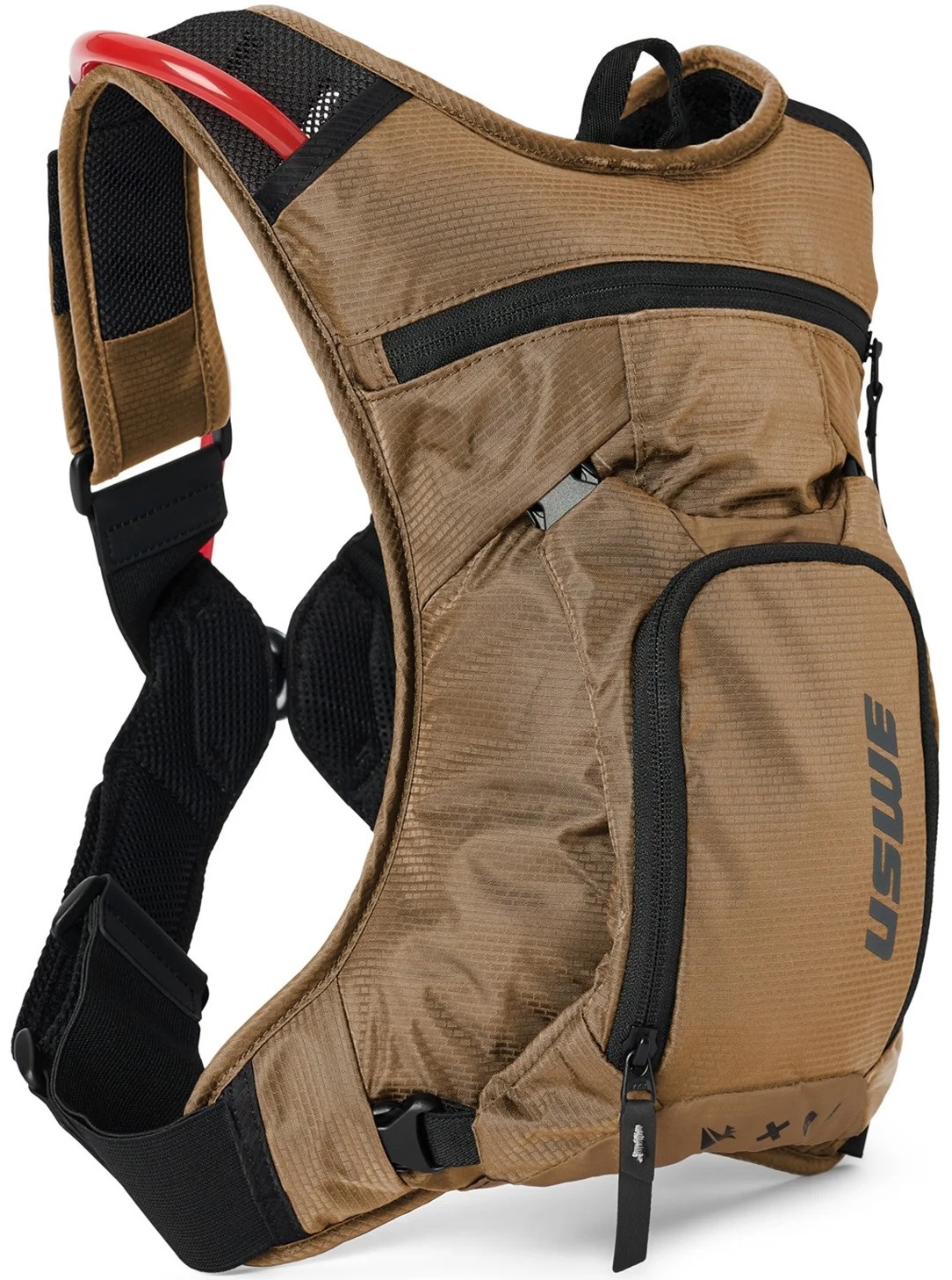 Capacities: 3, 8, 9, 12L
Capacities: 3, 8, 9, 12L
Reservoir included: Yes (2L)
Weight: 15.1 oz.
What we like: Innovative harness system offers a secure, snug fit.
What we don’t: Expensive, lacks on-the-go storage, and can be tough to find.
USWE (pronounced “you-swii”) is a Swedish brand with origins in dirt biking, and they brought that expertise into the MTB space with a unique—and eye-catching—harness design. The trademarked “No Dancing Monkey” system offers a secure, adjustable, non-restrictive fit that attaches to your chest with a single buckle (i.e., no sternum strap). The elastic straps stretch to accommodate heavy breathing but also manage to stay taut and snug enough for when your heart rate lowers. We were admittedly skeptical of the cumbersome-looking setup, but we found that the harness effectively prevents major bouncing even with the 2-liter water reservoir filled. Storage is limited at just 3 liters (there are 8, 9, and 12L capacities available), but we appreciate that USWE included a detachable 1-liter pocket, and you can purchase add-ons like a waterproof phone pocket and camera harness to boost organization.
However, we have a few gripes that push the USWE lower on our list. For the price, we’re disappointed to see that it lacks stretchy dump pockets for easily stowing layers, and without shoulder strap pockets, access to snacks and tools is slightly less convenient. It’s also worth noting that the design/location of the harness strap could be uncomfortable for women with larger chests. Lastly, we've noticed that the pack can be tough to track down. Stock is almost always low or out on USWE’s site, but if you’re lucky, you can find some still available on Evo or Backcountry. All that said, this pack has gained a lot of traction in the professional riding and racing community and for good reason—its figure-hugging, no-bounce harness works really well (as long as you can get your hands on one).
See the USWE MTB Hydro 3L
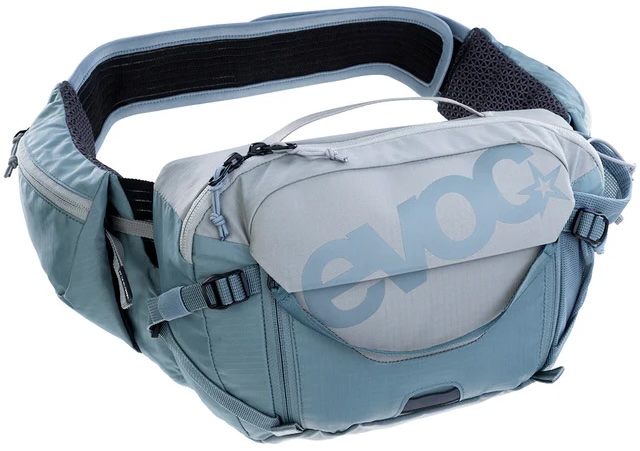 Capacity: 3L
Capacity: 3L
Reservoir included: No
Weight: 15.2 oz.
What we like: Seemingly endless adjustability and pockets galore.
What we don’t: Overcomplicated, expensive for the capacity, and doesn’t carry as well as the other waist packs on our list.
The third waist pack to make our list this season is Evoc's Hip Pack Pro 3, which is more feature-packed than both the Dakine Seeker 6L and Patagonia Dirt Roamer 3L above. One of our favorite parts about this pack is its ability to fit a wide range of body types, with excellent adjustability and extra-wide hip "wings" that do a great job distributing weight. Between the generously cushioned backpanel, fully padded hipbelt, and Air Flow Contact System that maximizes ventilation, the Hip Pack Pro is extremely comfortable to carry and highly breathable to boot. Plus, the materials are top-notch—our tester equated it to "German car quality." You also get space for a 1.5-liter reservoir (not included), dedicated water bottle carry, and more storage options than we know what to do with—including a front pocket that unzips completely for quick and easy access to tools and small accessories.
All that said, the Evoc Hip Pack Pro 3 does feel a bit over-engineered. In sum, this isn't a design that you can pull out of the box and toss on—it took some time for us to familiarize ourselves with the adjustments and organization layout. And to be honest, we're not sure that the more complicated design adds much to overall appeal—the Seeker and Savu waist packs above will get the job done with less of a learning curve. Further, while the Evoc is highly adjustable, our lean tester had issues dialing in a secure fit, and the pack felt a little unwieldy when fully loaded (especially if you use the single water bottle pocket, which can throw it off-balance). Finally, this pack is on the pricey end, and we're disappointed that no hydration bladder is included. In the end, riders who like to geek out on organization and features may find a lot to like about the design, but minimalists will be better served by the Dakine or Osprey hip packs above.
See the Evoc Hip Pack Pro 3
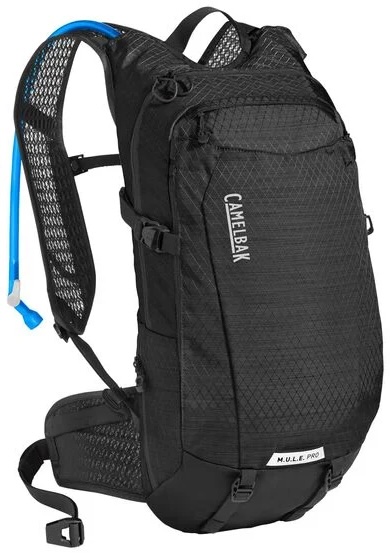 Capacity: 11L
Capacity: 11L
Reservoir included: Yes (3L)
Weight: 1 lb. 13.8 oz.
What we like: Big water reservoir, excellent ventilation, and optional impact protection available as an add-on.
What we don’t: Not a standout in comfort; sculpted backpanel eats into usable interior space.
CamelBak has a healthy lineup of mountain bike pack offerings, and sitting near the top is the Mule Pro 14—a souped-up version of their bestselling Mule hydration pack. In terms of best uses, the pack’s larger capacity (the standard Mule is 9.5L), 3-liter water bladder, easy-to-use helmet carry, and highly breathable layout make it a great choice for long rides (the extra space also comes in handy if you haul kiddos around on a Mac Ride or Shotgun seat). For staying cool, there’s extensive use of open-weave mesh on the shoulder straps, and the sculpted backpanel has suspended mesh to keep air flowing. And injury-conscious riders will appreciate that CamelBak offers a compatible impact protection panel—in all, the setup handily undercuts the price of the Evoc Trail Pro above.
Why is the Mule Pro ranked here? While it has a lot of great features, including a second battery sleeve for e-bikes, it lacks the refinement of our top picks. The contoured shape impacts comfort—the base is pretty firm, and we had some complaints about rubbing along our lower back. Usable interior space is also impacted by the backpanel, and we found it difficult to truly leverage the higher capacity with bulkier items like pads. Finally, the Mule’s hose magnet (which sits on the sternum strap) doesn’t hold well and pops off easily while riding. These complaints are enough to push the Mule Pro below alternatives like the Evoc Trail Pro (if you want back protection) and Osprey Raptor (for a traditional pack), but it remains a solid do-everything option.
See the Men's CamelBak Mule Pro 14 See the Women's CamelBak Mule Pro 14
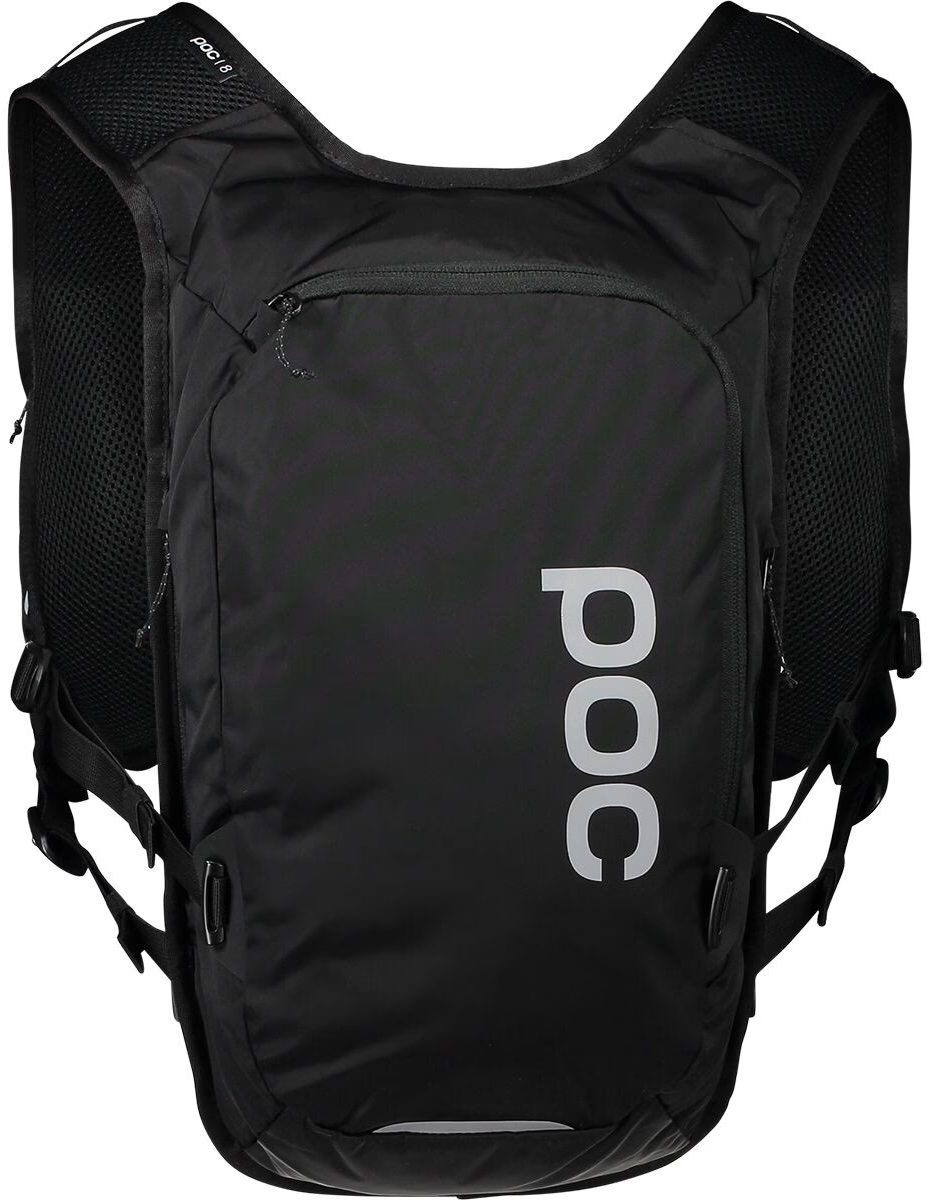 Capacity: 8L
Capacity: 8L
Reservoir included: No
Weight: 1 lb. 8.0 oz.
What we like: Essentially a biking vest with back protection; lightweight and comfortable.
What we don’t: Expensive and doesn’t include a reservoir; breathability is still compromised.
Evoc’s Trail Pro 10 above is our favorite pack with integrated back protection, but if you’re looking for something smaller and lighter weight, POC’s Column VPD Backpack Vest is worth considering. The main event is the VPD Air Protector which aims to provide confidence-inspiring spine protection without sacrificing too much breathability. The protector itself is filled with holes—literally—to promote airflow between the protector and the user’s back. The remaining capacity is dedicated to storage: The main compartment can hold a 3-liter reservoir (not included) and has smaller pockets for organizing tools, snacks, and valuables. Like our vest pick above, the Column VPD also has zippered storage along the shoulder straps and foregoes a hipbelt for dual adjustable sternum straps.
For those unwilling to compromise on back protection, the Column VPD is a compelling design, but it’s not without its faults. The most obvious downside is its price tag, which isn’t much lower than the Trail Pro 10. The Column VPD also doesn’t include a reservoir, which is disappointing for the price point. Additionally, users have reported negatively on the breathability of the pack, despite the protector’s ventilation. While we do think the backpanel mesh could be improved to help with breathability, this seems to be one of the tradeoffs in opting for a pack with integrated back protection. The Column could use some refinement in other areas, such as the hose attachment, which currently consists of two straps along the shoulder that don’t do much to keep a hose from flapping in the wind. Lastly, some more pockets along the shoulder straps would also really round out the vest half of the design. Despite those nitpicks, the Column VPD is a compelling design for those who are big on protection but don't need the bulk of an overbuilt design.
See the POC Column VPD Backpack Vest
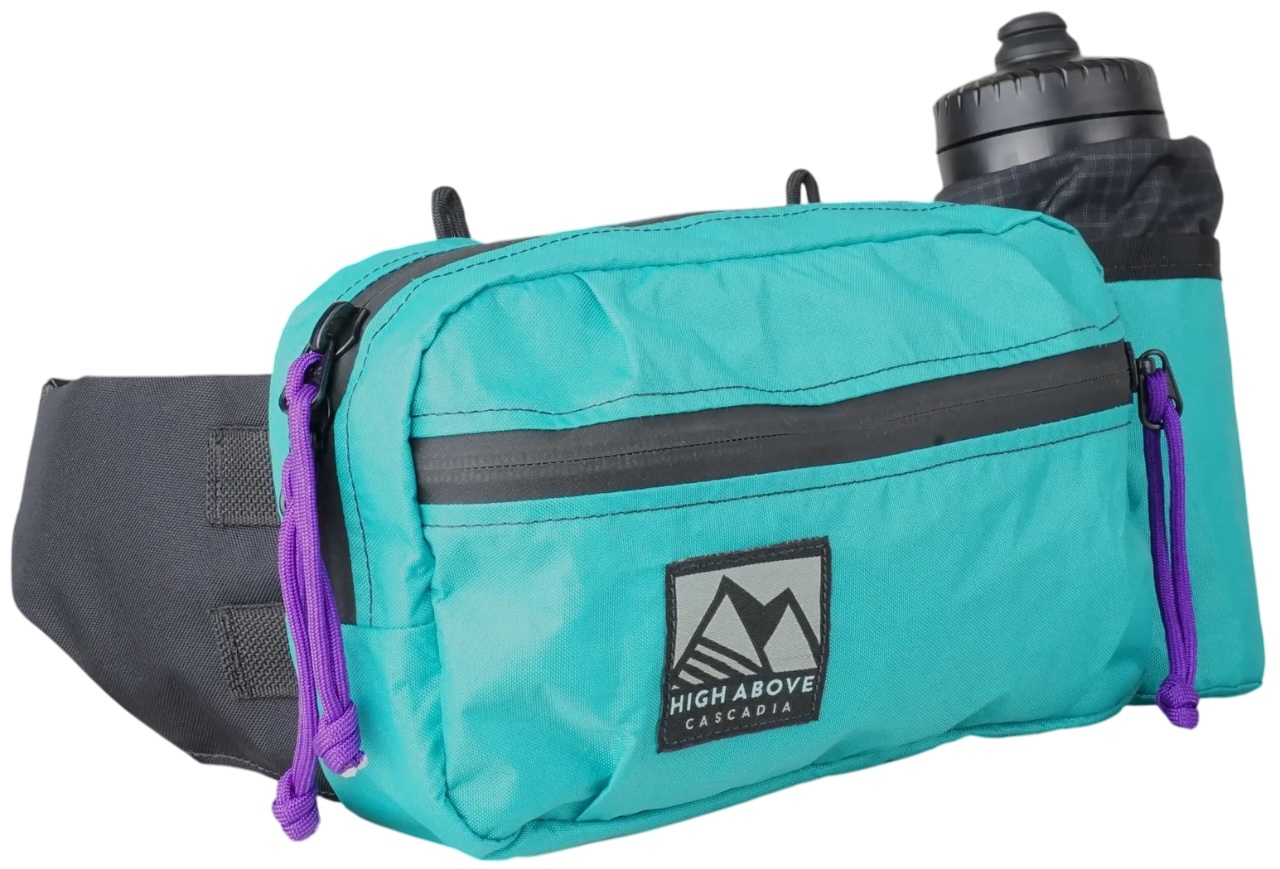 Capacity: 2.7L
Capacity: 2.7L
Reservoir included: No
Weight: 9.9 oz.
What we like: Hip pack from a cottage brand that will earn you some serious trail cred.
What we don’t: Expensive, small, and doesn't have the most intuitive hydration carry.
We might be biased, but there's a lot of sweet bike gear coming out of Bellingham, Washington these days (our editor and several of our biking gear testers hail from the bike-centric PNW town), and High Above is certainly one of them. High Above is a cottage bike gear brand that has been hand-making hip belts, water bottle holders, and backpacks since 2012. Their flagship Lookout 2.7L hip pack serves more than just retro vibes, but also thoughtful tool organization throughout its two zippered pockets and a side water bottle pocket that can hold a 22-ounce water bottle (not included). The materials are nothing short of high quality, including a heavy duty recycled polyester shell fabric reinforced with a PFAS-free DWR, Fidlock waistbelt buckle, and YKK Aquaguard zippers. Put together, The Lookout is a no nonsense design that provides just enough storage for lunch laps or to complement frame storage.
That said, we can't help but think that The Lookout is best utilized as a complement to storage you already have installed on your bike. For one, the 2.7-liter capacity is a bit small for any serious days on the trail, and the single water bottle holder doesn't carry enough water for more than a few hours of riding in the summer heat. You can purchase an additional water bottle pocket to attach to the other side of the pack—which will undoubtedly distribute weight more evenly across the pack—but that's only adding to the already high price tag. And like the Osprey Savu above, the water bottles simply aren't as easy to access as a reservoir hose. Gripes aside, we think The Lookout offers a refreshing take on the overbuilt options here, and there's no doubt you'll get plenty of complements when taking this pack out on the trail. If you're looking for something a bit bigger, High Above also makes the Supernatural Vest Pack 6L, which comes with a 2-liter Hydrapak reservoir and enough storage for demanding days.
See the High Above The Lookout 2.7L
| Mountain Bike Pack | Price | Weight | Capacities | Reservoir | Fabric | Helmet?* |
|---|---|---|---|---|---|---|
| Osprey Raptor 10 | $170 | 1 lb. 11.8 oz. | 10, 14L | 2.5L | 210D | Yes |
| Osprey Katari 7 | $90 | 1 lb. 3.8 oz. | 1.5, 3, 7L | 2.5L | 100D | No |
| Dakine Seeker 6L | $125 | 13.0 oz. | 6L | 2L | 450D | No |
| Evoc Trail Pro 10 | $240 | 1 lb. 15.7 oz. | 10, 16, 26L | None | 200D | No |
| Patagonia Dirt Roamer 20L | $159 | 1 lb. 8.0 oz. | 20L | 2L | 210D | Yes |
| Evoc Hydro Pro 3 | $140 | 8.8 oz. | 1.5, 3, 6L | 1.5L | Unavail. | No |
| Osprey Savu 5 | $65 | 13.3 oz. | 2, 5L | None | 600D & 400D | No |
| Thule Vital 8L | $160 | 1 lb. 3.4 oz. | 3, 6, 8L | 2.5L | Unavail. | No |
| Dakine Seeker 18L | $215 | 1 lb. 15.8 oz. | 10, 18L | 3L | 210D & 420D | Yes |
| USWE MTB Hydro 3L | $160 | 15.1 oz. | 3, 8, 9, 12L | 2L | 100D | No |
| Evoc Hip Pack Pro 3 | $115 | 15.2 oz. | 3L | None | Unavail. | No |
| CamelBak Mule Pro 14 | $176 | 1 lb. 13.8 oz. | 11L | 3L | 200D x 290D | Yes |
| POC Column VPD Backpack | $190 | 1 lb. 8.0 oz. | 8L | None | Unavail. | No |
| High Above Lookout 2.7L | $140 | 9.9 oz. | 2.7L | None | Unavail. | No |
*Editor's note: This column denotes if a helmet carry system is included. The listed weights are for the men's or unisex version of each pack.
We always look forward to testing mountain biking gear because it means we get to spend time on the trail, whether we're embarking on a short after-work ride or tackling long, winding singletrack in the alpine. In assembling our list of 14 capable mountain bike packs above, we relied on feedback from several trusted contributors. Longtime gear testers Brian McCurdy and Sasha Brown are do-it-all recreationists who have bikepacked through some of the most scenic and wild landscapes across the globe, from the Mountain West to rural Mongolia. Mountain bikers Liza Kimberly and Paul Kalifatidi also contributed to the round-up, sharing their expertise as avid riders who spend significant time on two wheels (Paul also contributed several photos for this guide).
When testing mountain bike packs, we do our best to expose them to a range of conditions—from muddy singletrack to high and dry alpine trails—and take them on as many objectives as possible, from lunch laps to multi-week bikepacks. Comfort is always at the top of our priority list: We look for well-padded straps that don't cause irritation or chafing, breathable backpanels that keep air flowing, and storage layouts that make it easy to distribute weight evenly. Once we load each pack up, we pay close attention to carry-ability and fit customization, tweaking the straps until we're able to dial in a secure fit with minimal bounce (which isn't always possible). Finally, we evaluate long-term durability by keeping an eye on the exterior fabric as well as smaller components like zippers and buckles. As the market continues to evolve, we'll be sure to keep the list above current by incorporating any standouts that we test.
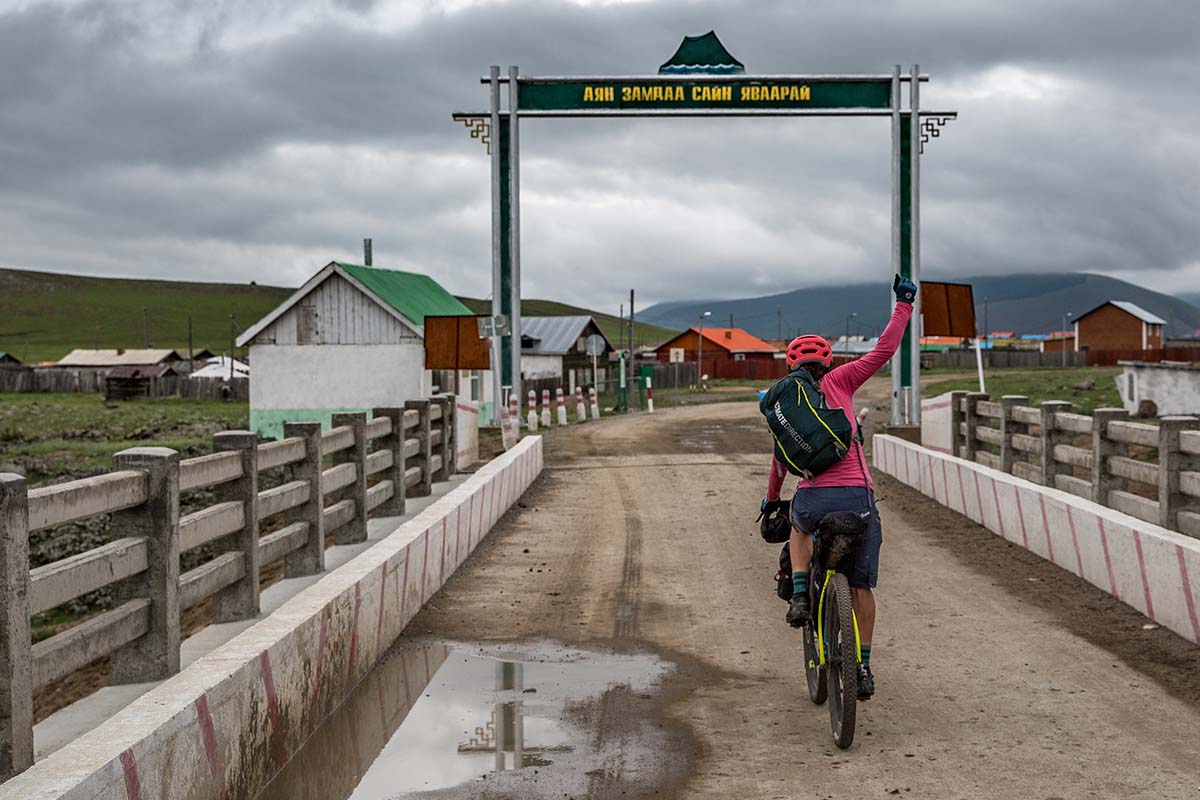
Like backpacks designed for other activities, mountain bike packs are available in a variety of capacities depending on your gear needs and the length of your typical ride. On our list above, designs range from small and minimalist waist packs like the High Above The Lookout 2.7L and Evoc Hip Pack Pro 3 to the super spacious Patagonia Dirt Roamer 20L. For all-day and remote outings that require substantial water intake and a full workshop of tools, a bigger option like the Dirt Roamer 20L or Dakine Seeker 18L makes a lot of sense. If after-work hot laps are more your style, a smaller model like the Evoc Hip Pack Pro 3—or their running vest-inspired Hydro Pro 3—might be sufficient. And the sweet spot for many will be somewhere in between, including our top-rated Osprey Raptor 10. Below we break down the various pack volume ranges by category and best use(s).
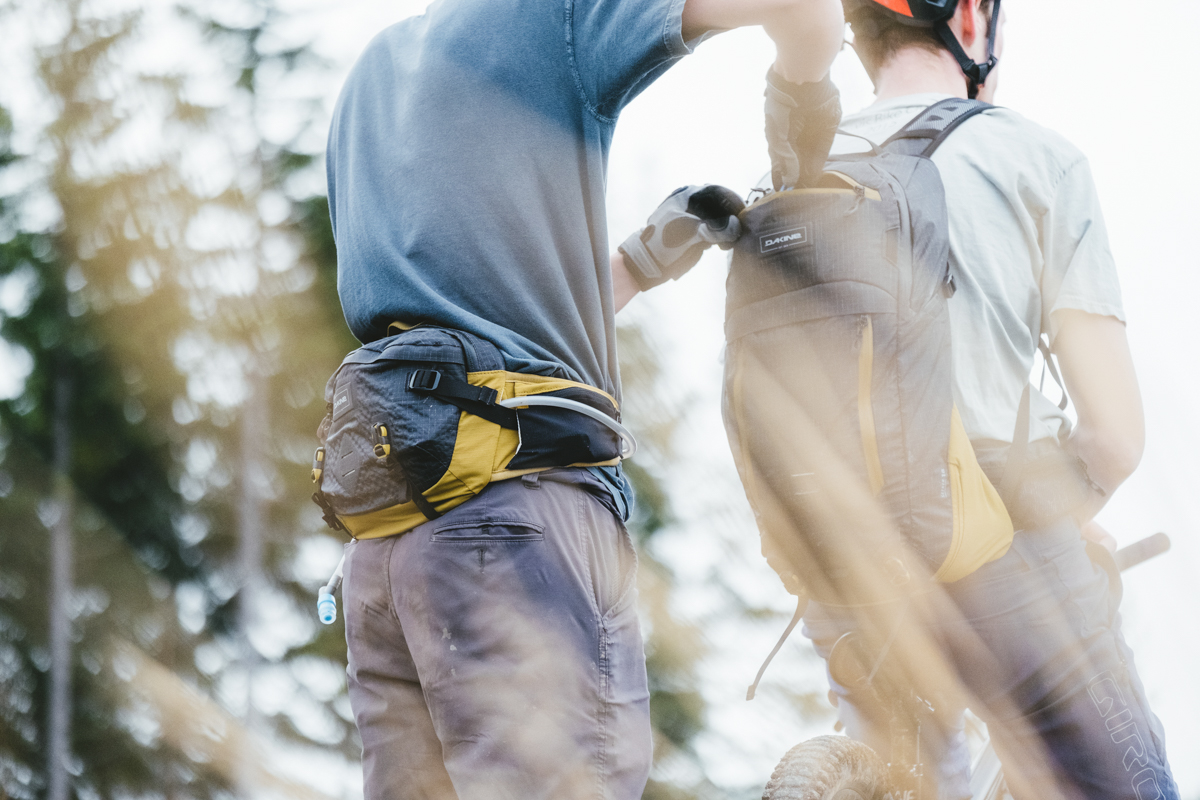
5 Liters and Under: Just the Essentials/Quick Rips
Packs with 5 liters or fewer of carrying capacity, like the Evoc Hydro Pro 3 and High Above The Lookout 2.7L, are best suited for quick rides that require minimal gear and water. That said, 5 liters can fit a surprising number of essentials: keys, a bike tools, a phone, a lightweight wind layer, and a bar. This volume can also suffice if you have additional organization on your bike in the form of an under-seat tool bag or a storage compartment on (or in) your frame. And finally, small packs are a nice option for races when you’re able to refill water and resupply at aid stations.
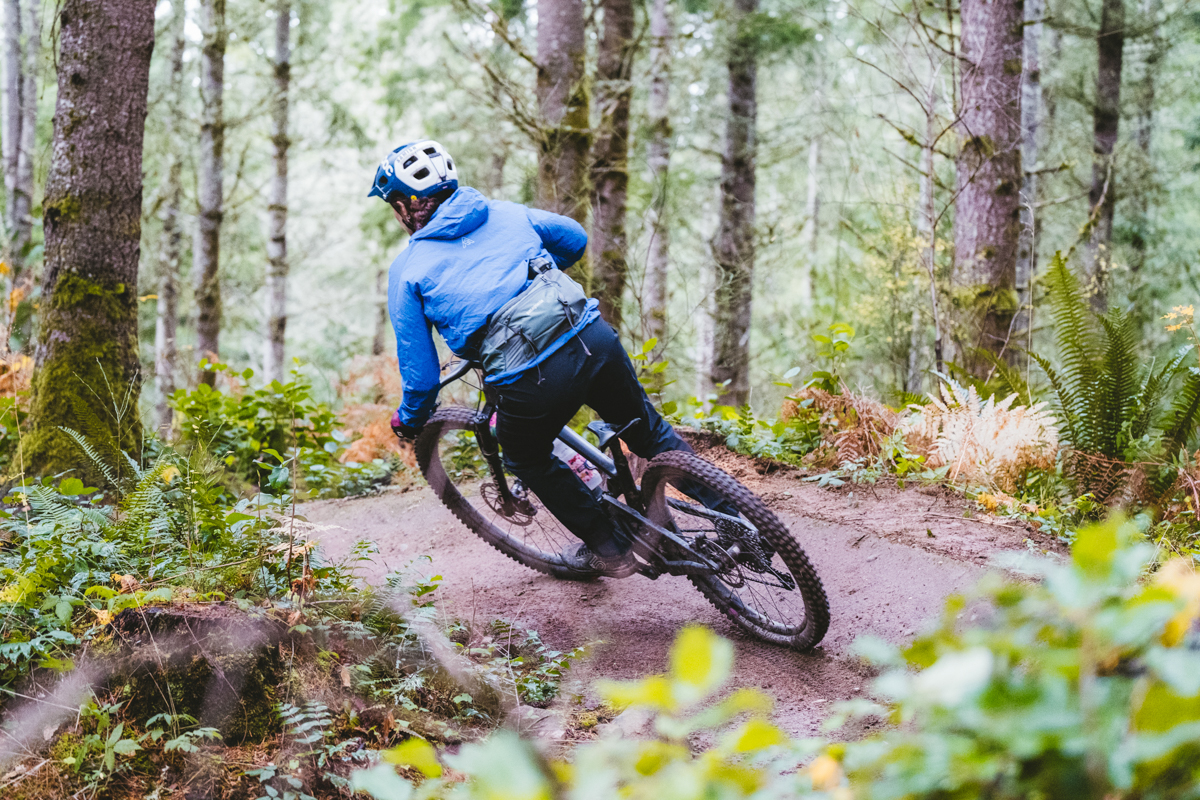
6-9 Liters: The Essentials “Plus”
If you’re venturing out on a longer ride, you probably need space for the essentials and then some. With 6 to 10 liters, you can fit a more protective rain shell, additional water, and a heftier first aid kit. However, this capacity is a bit of a tweener size, in our opinion: slightly larger than minimalist designs but not quite big enough to keep you comfortable and hydrated during all-day outings. In our experience, packs in the 7- to 9-liter range (like the Osprey Katari 7 and Thule Vital 8L) are best for rides that don’t last more than a few hours.
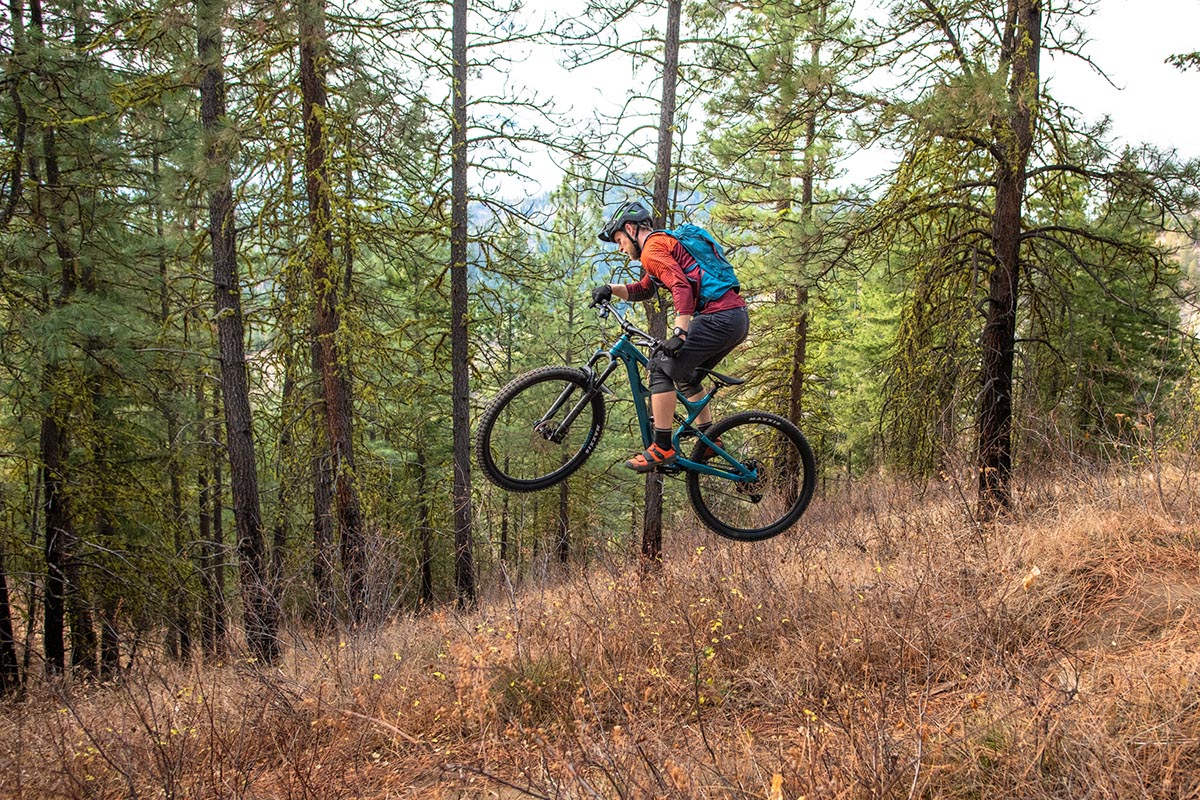
10-15 Liters: The All-rounder Capacity
The 10- to 15-liter volume is the goldilocks capacity for us and the range we’d go with if we had to choose just one pack. The versatility is hard to beat: You can use compression straps to reduce unwanted space during hot laps but then expand it into a voluminous pack for longer or more gear-intensive rides. At this volume, there’s enough space to carry a couple liters of water, and you won’t have to make as many compromises when packing (no need to decide between the brownie or the warm hat—bring them both!). We tested packs of this size on the Whole Enchilada in Moab—a classic big ride with 7,000 feet of descending —and had plenty of room to fill our reservoirs to the brim, stow additional layers for the cold morning, and bring an array of snacks and gels.
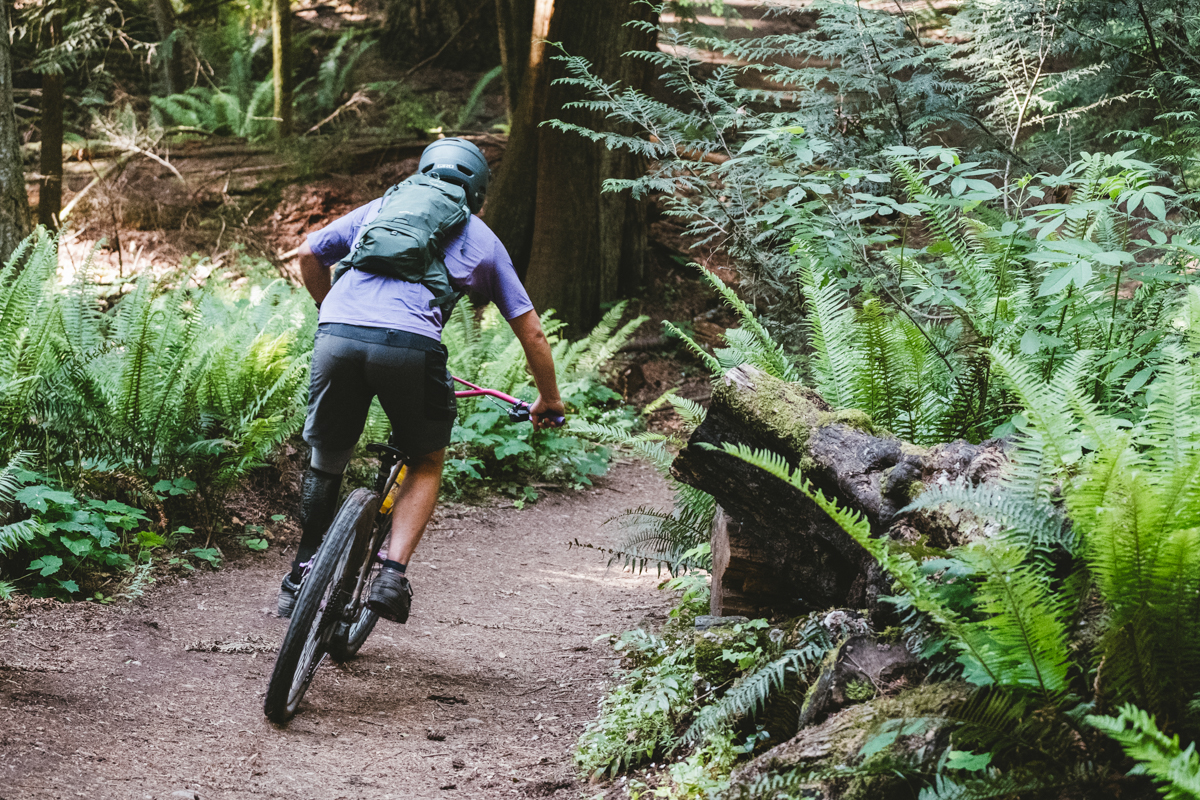
16L+: Long Epics and Gear-Intensive Days
If you’re an adventurous rider who gravitates toward big, epic days like Gifford-Pinchot traverses and backcountry trips to the Chicoltins, a larger pack is likely your best bet. Packs in the greater-than-16-liter category, like the Patagonia Dirt Roamer 20L and Dakine Seeker 18L, provide ample space for multiple layers (even a puffy jacket) to accommodate unpredictable mountain weather. They have no problem fitting items like a water filter, robust repair kit, navigational gadgets, and even more specialized equipment like an SLR camera kit or trail work tools. Keep in mind that packs this big are more likely to feel unwieldy when stuffed full—you’ll want to be cognizant of weight distribution when packing—and are decidedly overkill for the average ride, but they have their place for lengthy and gear-heavy outings.
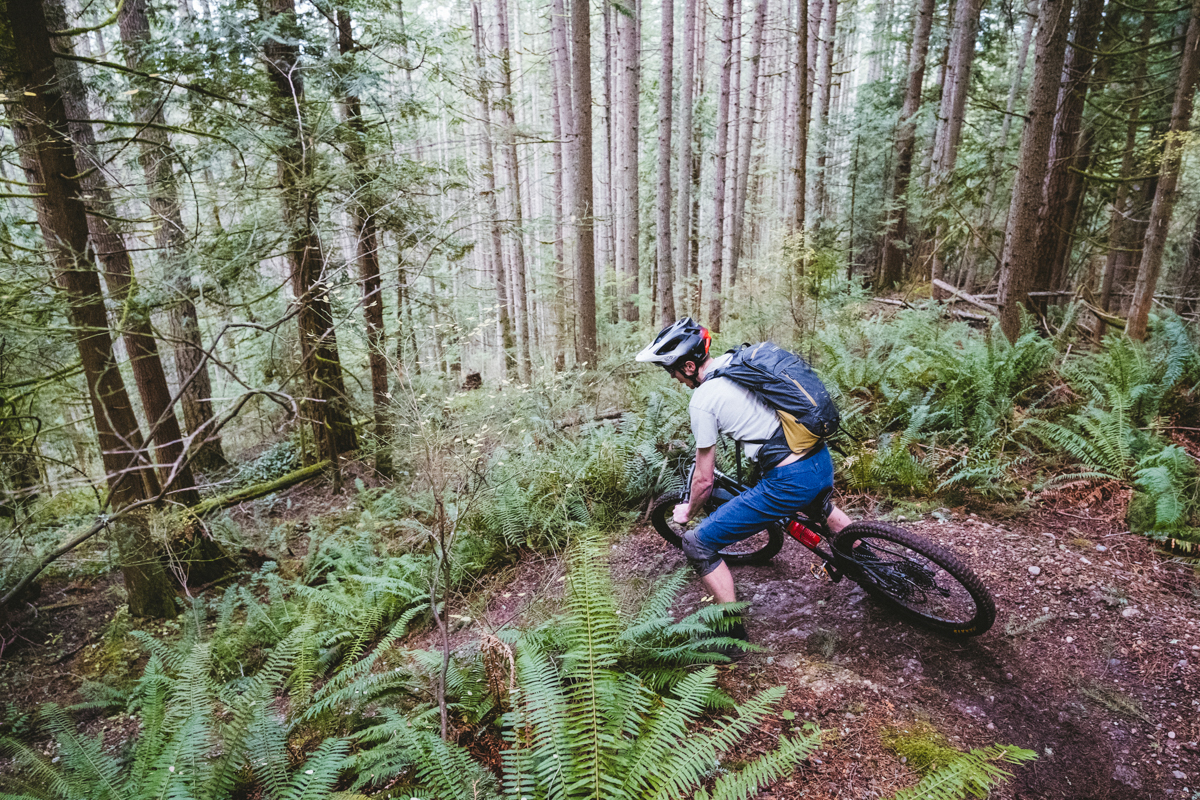
Out on the singletrack, you’ll likely encounter folks who are adamant wearers of waist packs (also known as hip packs, fanny packs, or lumbar packs) and others who are proponents of traditional backpacks. At the end of the day, a decision between the two designs largely boils down to your intended use(s) and personal preference. By nature, backpacks tend to have more volume (7-25L), which translates to more water-carrying capacity and additional space for a windbreaker, snacks, and tools—a great fit for longer days out. Waist packs, on the other hand, are lower-volume (typically 1-6L) and better suited for shorter rides or days at the bike park. Most waist packs fit just the essential items (e.g., a granola bar, tool, and phone), and some offer detachable holsters for securing a water bottle.
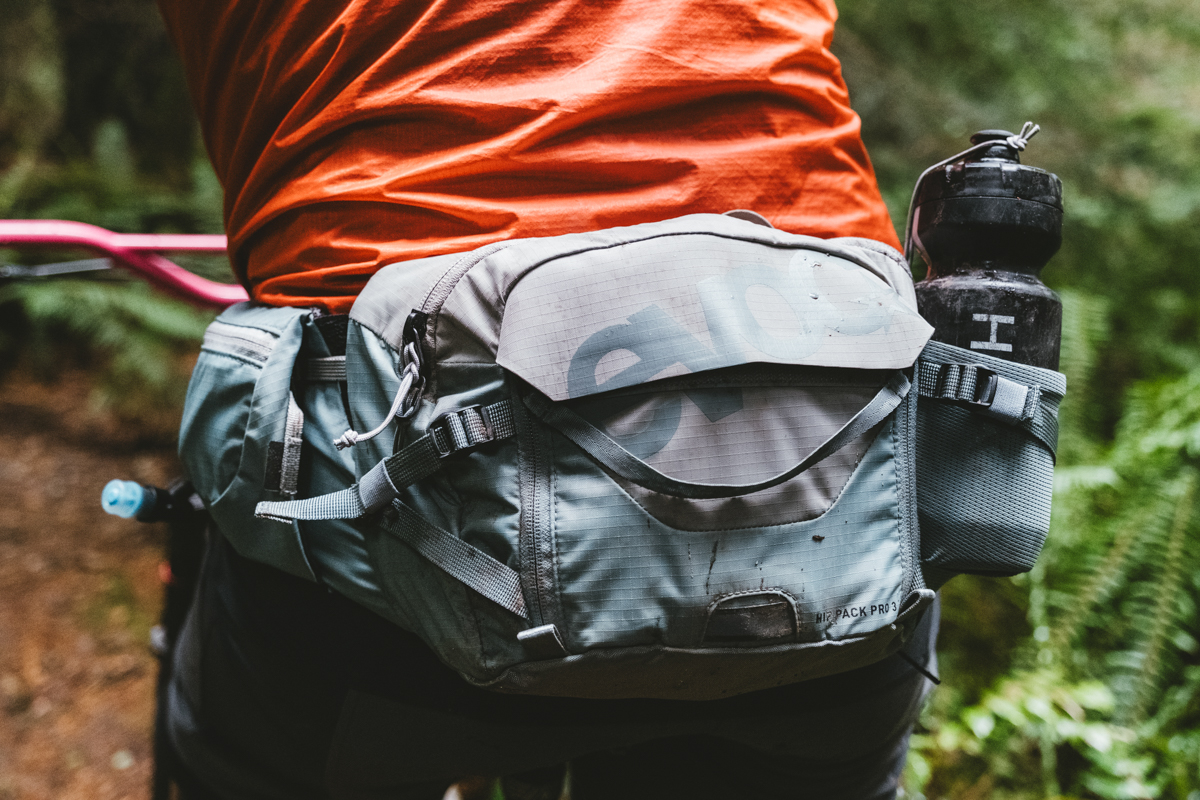
One consideration to keep in mind is that overloaded waist packs can feel unstable and bouncy, while backpacks distribute weight more evenly and keep the load closer to your back. However, with more coverage comes less breathability. Waist packs are generally cooler on hot summer days, but don’t be fooled—your lower back produces a lot of sweat, and the thickness and construction of the hipbelt can have a sizable impact on ventilation. Some riders also like the added assurance of having full coverage along their back in the event of a fall—although for the utmost in protection, you’ll want to go with a dedicated protector pack like the Evoc Trail Pro or POC Column VPD Backpack Vest. In the end, both have their places, and we find ourselves rotating between designs depending on the adventure of the day. For our favorite waist packs, we currently swap between the Dakine Seeker 6L and Osprey Savu 5.
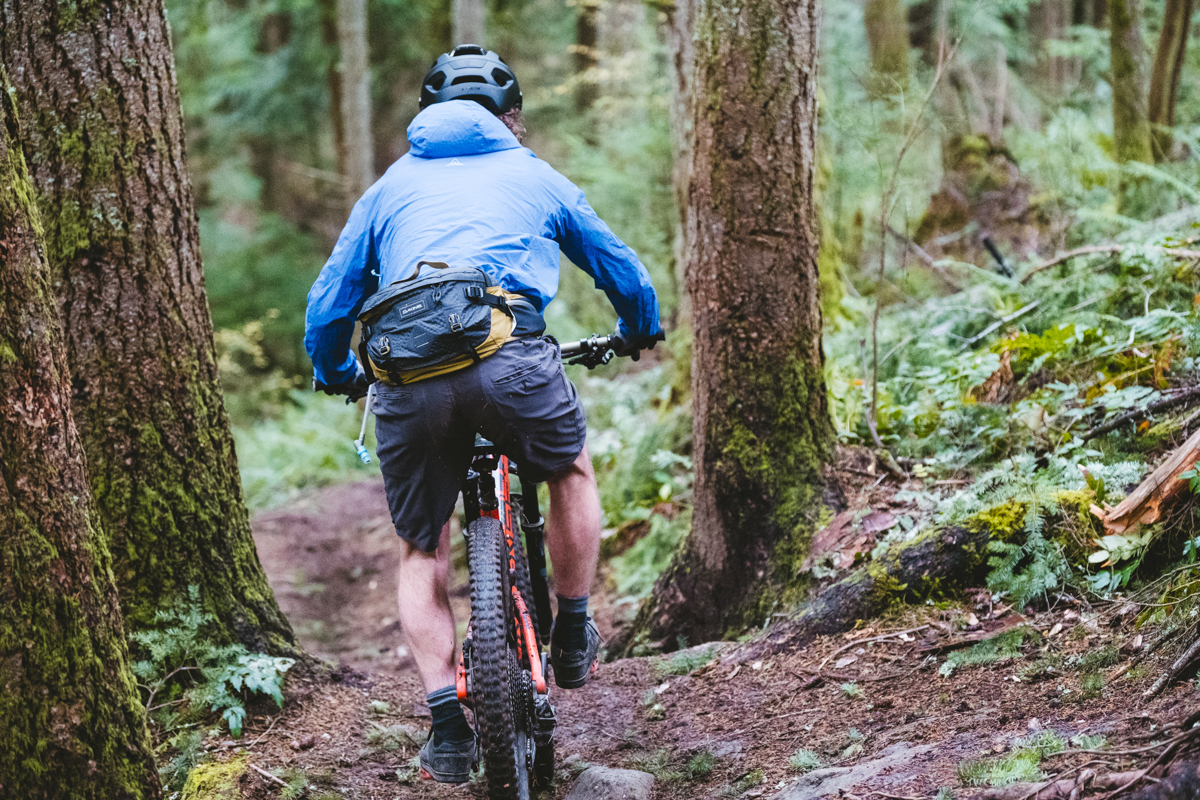
Reading the product descriptions above, you’ll see we make numerous references to pack comfort. A lot of factors come into play for a comfy-riding design, including fit and sizing (detailed below), but first and foremost are the shoulder straps and hipbelts. Starting with the former, we prefer light padding that offers enough cushioning for hauling a laden-down pack—a full water reservoir can weigh a surprising amount—but isn’t so bulky that it feels like it’s too far off your body. Additionally, shoulder strap shape is important, and you’ll see a number of the best options have an opened-up, winged layout to reduce restriction and potential pressure points as you reach forward to the handlebars. In general, you get nicer padding and more thoughtful shoulder strap designs as price goes up, including on packs like the Osprey Raptor 10, Dakine Seeker 18L, and Evoc Trail Pro.
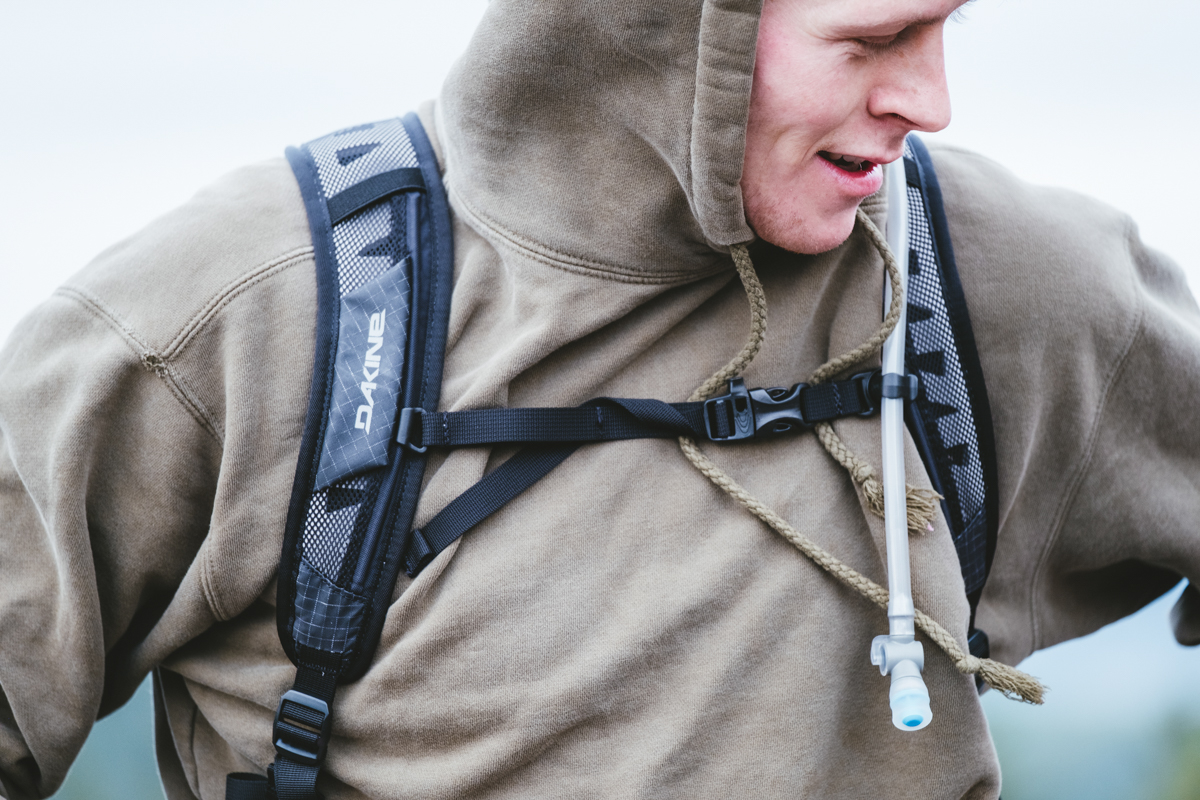
Hipbelts fall into two basic camps: webbing-only or wider shapes that feature a mesh lining. If you’re wanting only the basics and don’t plan to haul much weight or water at a time, a webbing-only belt like what’s found on the Osprey Katari can do the trick. That said, you can expect a noticeable drop in comfort: The webbing strap feels restrictive when you pull it snug, is unable to distribute much weight to take it off your shoulders, and doesn’t do as good of a job keeping the pack from bouncing around through technical sections. As a result, if you’re getting a standard backpack (i.e., not a vest-style design like the Evoc Hydro Pro 3), we think it’s worth opting for a wider belt. Most are very lightly padded and have a wider shape at the hips that keeps the pack close to you for better support, and some include pockets for small items like snacks. If you instead opt for a waist pack, wider hipbelts are the norm since they're tasked with all of the load distribution.
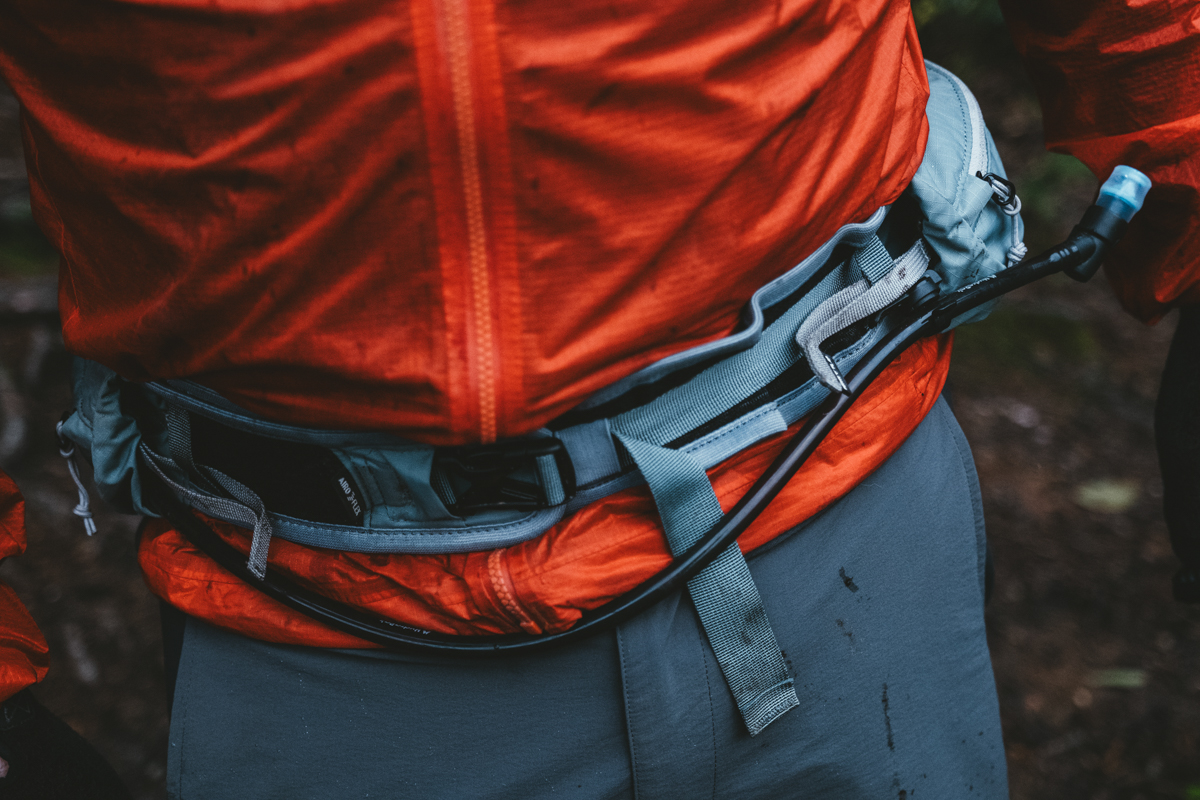
It’s hard to capture your friend sending a rock-roll with a cracked phone, and no one likes a soggy, squished granola bar. For these reasons (and many more), well-designed pockets and compartments are an important consideration when choosing a pack. Some riders prefer the simplicity of a single large pocket (like what you get with the Patagonia Dirt Roamer 20L), while others will appreciate a wider assortment of smaller spots for keys, a wallet, a phone, and bike tools. It’s also nice to have a separate space or external straps to stash a wet or muddy layer without dirtying or soaking your other gear. Final organizational features to consider include a dedicated tool kit pouch, a helmet attachment (like Osprey’s LidLock mechanism), an e-bike battery pocket, a water bladder sleeve (which we cover more in depth below) and a blinker light attachment—just to name a few.
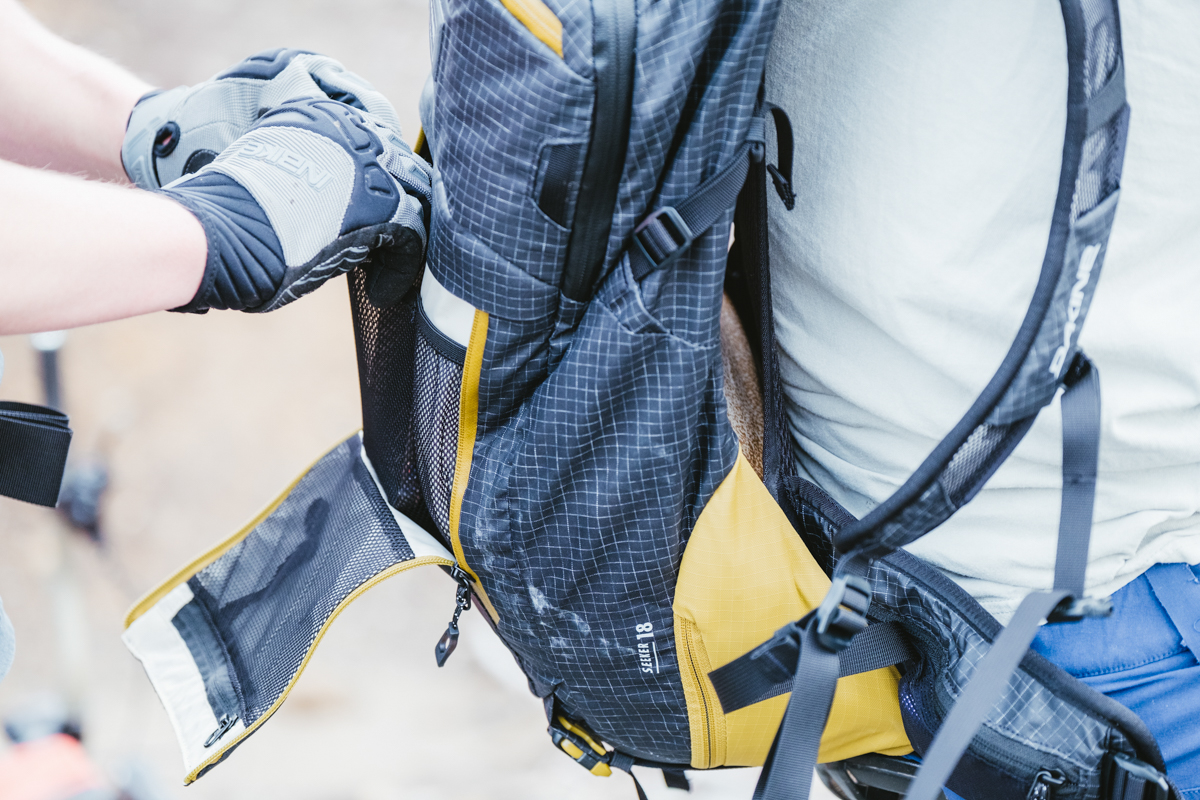
In general, we’ve found that most mountain bike packs (with the exception of waist packs) don’t prioritize pocket accessibility—perhaps as a way to discourage fumbling with gear while riding. That said, we appreciate the ability to quickly retrieve items like a snack or our phone, because stopping and taking off a backpack just to grab a bite of a granola bar can be a real annoyance. A few designs above are better equipped for the job than most. The Evoc Hydro Pro 3, for instance, has handy pockets on the shoulder straps (one major draw to the vest style), while the Osprey Raptor boasts large hipbelt pockets that are easy to access while riding.
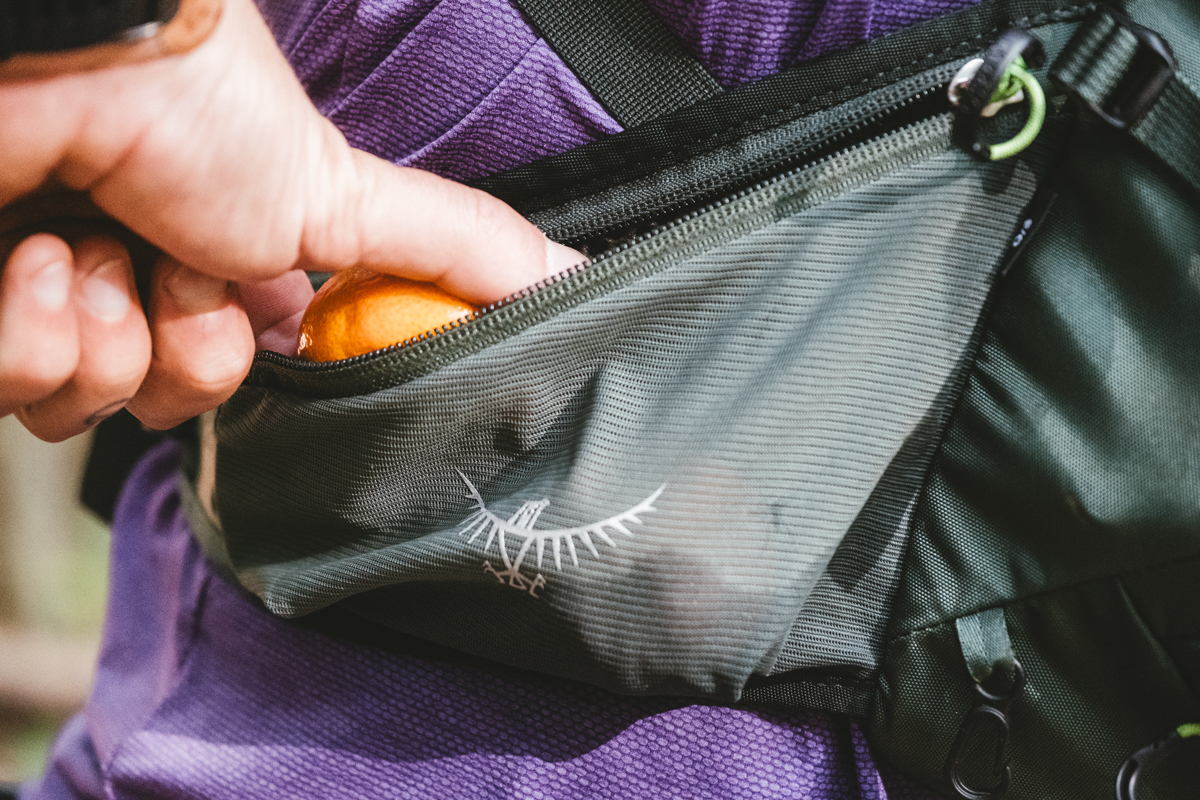
Most mountain bike packs come with a hydration reservoir (also commonly referred to as a bladder), but some brands, like Evoc, require that you purchase one separately. On our list, Osprey, REI, Dakine, Patagonia all use HydraPak-brand reservoirs (though they might add their own design features), while CamelBak uses their own line of bladders. Below we break down important design considerations between the various sizes and styles.
Reservoir Capacities
Hydration-equipped mountain bike packs generally come with a reservoir in the 1- to 3-liter range—and most of the time, this decision is made for you when you purchase your pack. For example, the Patagonia Dirt Roamer 20L features a 2-liter reservoir, while the CamelBak Mule Pro 14 comes with a 3-liter bladder. That said, it’s often possible to mix and match reservoirs. If you’re biking in particularly warm weather or know you’ll be out for a long time without the ability to refill, bumping up to a larger model can be a good idea—just make sure it fits inside your pack. And while it’s also possible to swap in a smaller-capacity reservoir, the easier solution is to just fill your existing bladder halfway. Pro tip: If you go this route, invert the reservoir after filling and suction out air through the hose to mitigate sloshing.
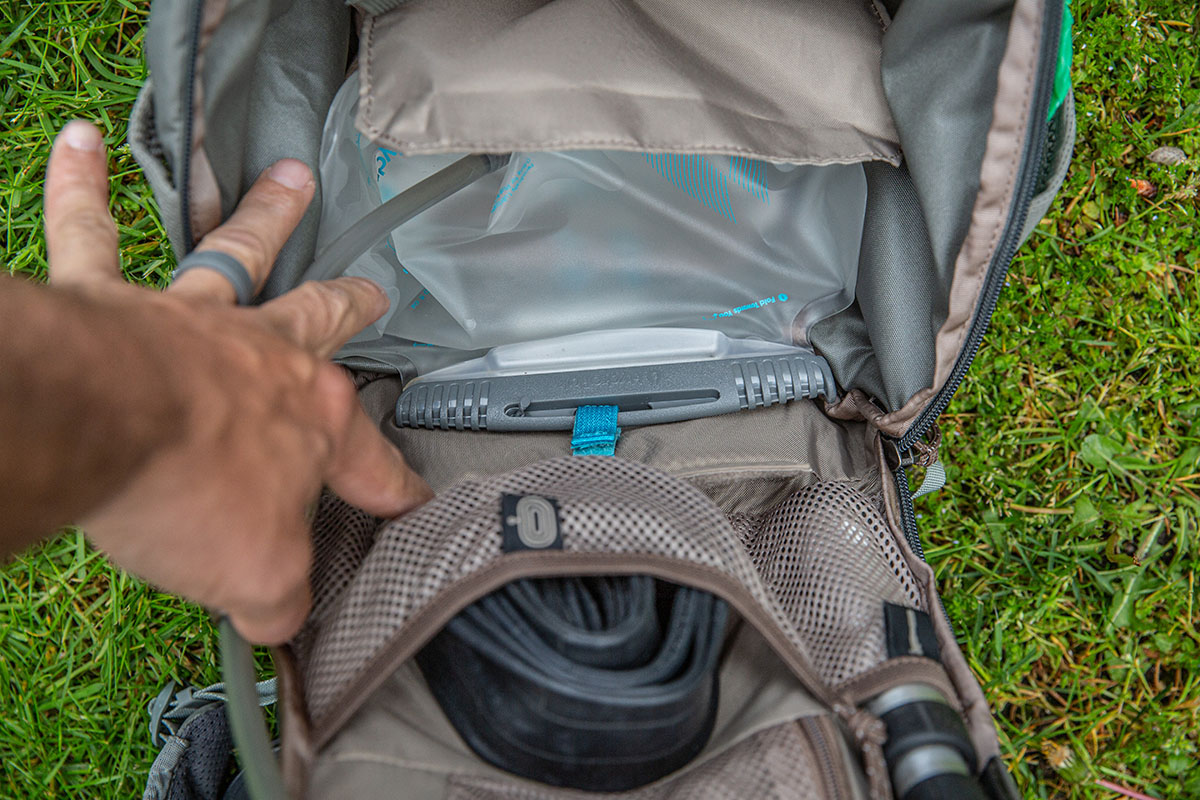
Openings Styles: Slider vs. Twist Cap
Reservoirs generally feature one of two primary opening mechanisms: a top opening that folds and seals with a slider (like those from HydraPak) or a large, threaded opening with a twist-off cap (like those from CamelBak). The slider on a HydraPak bladder is arguably easier to fill solo thanks to the bigger opening. We’ve also found the lid on many CamelBak designs to be a bit finicky—we’ve soaked our packs after failing to line up the threads precisely or tightly enough on several occasions. This is largely a matter of personal preference, however, and the opening style on your bladder may or may not be an important consideration for you.
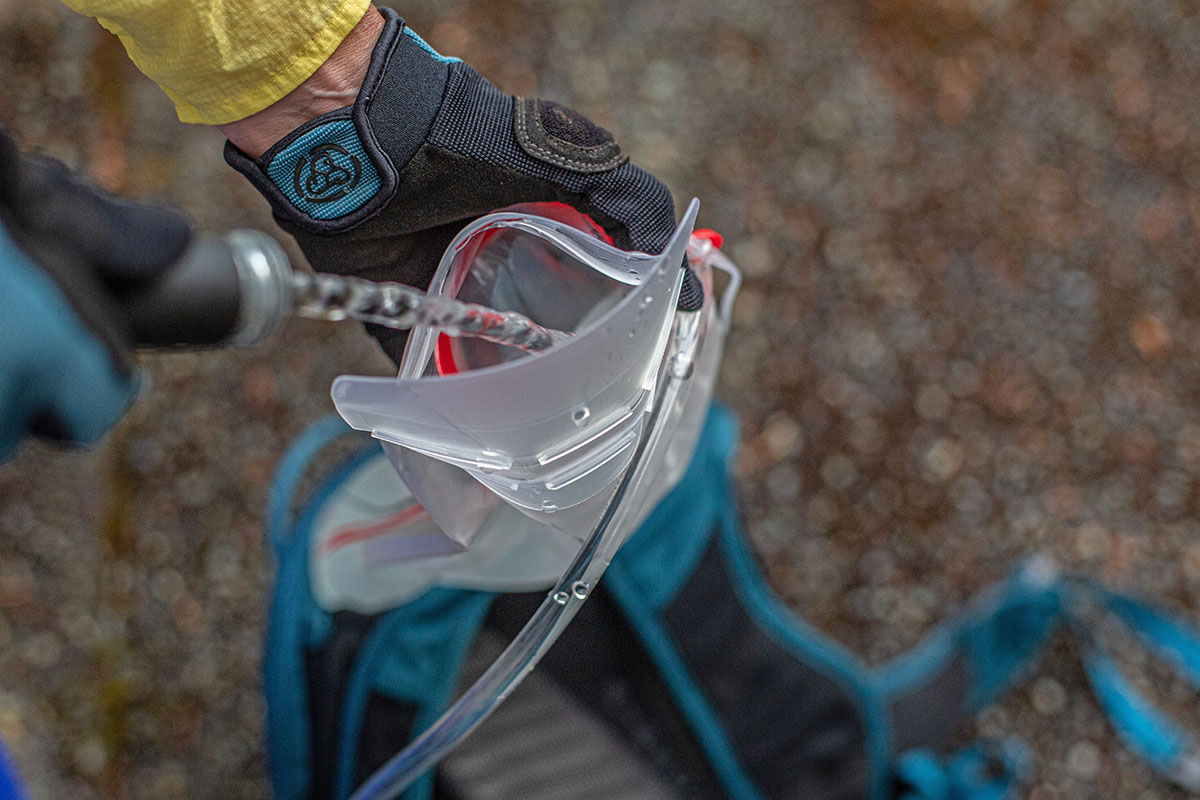
Bite Valves
Bite valves are a convenient way to hydrate while pedaling, and the mechanism is very simple: Gently compress the valve by biting down, and water will begin flowing through the hose as you suck. The primary difference between valves is the on/off mechanism: CamelBak’s and Osprey's feature a lever, while most HydraPak designs twist open and closed. The majority of bite valves are fairly easy to use and leak-free, although we’ve found that CamelBak’s require less suction, which is certainly a bonus (they claim their Crux reservoirs offer 20% more water per sip, which lines up with our experiences). Bite valves are imperfect and occasionally fall off—we’ve already lost one on our Patagonia Dirt Roamer 20L—but fortunately, it’s an easy and cheap (typically under $10) replacement.
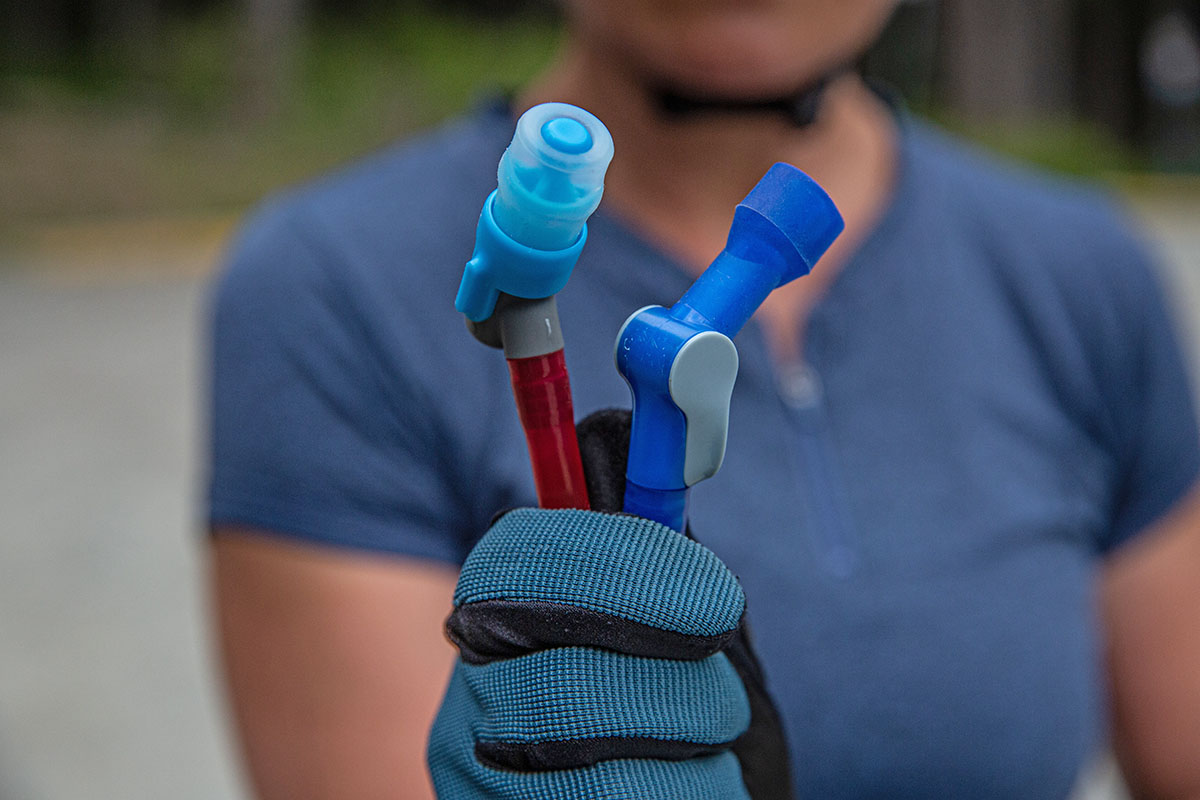
Hose Attachment: Magnet or Clip
When you’re pumping corners and scaling rooty trails, your hands aren't free to reach to re-secure your bladder hose as they might be when you’re running or hiking. With that in mind, we really value an easily accessible hose attachment, and especially one that doesn’t flop around while riding. Most hoses are held in place by a quick-release magnet or clip. The majority of packs above use the former, which makes attaching and unattaching very easy—place the magnets close to each other and let physics do the rest. The magnet is located either across the body on the sternum strap (common on Osprey packs but also found on the CamelBak Mule Pro) or on the same side as the hose (like the Thule Vital).
Of note: We’ve found that the hose occasionally squiggles out of place with the across-the-body design. To combat this, Patagonia and most CamelBak packs have a clip to keep the hose in place, which involves unclipping it in order to sip—a somewhat tedious step to execute while riding but arguably worth the effort for the added security.
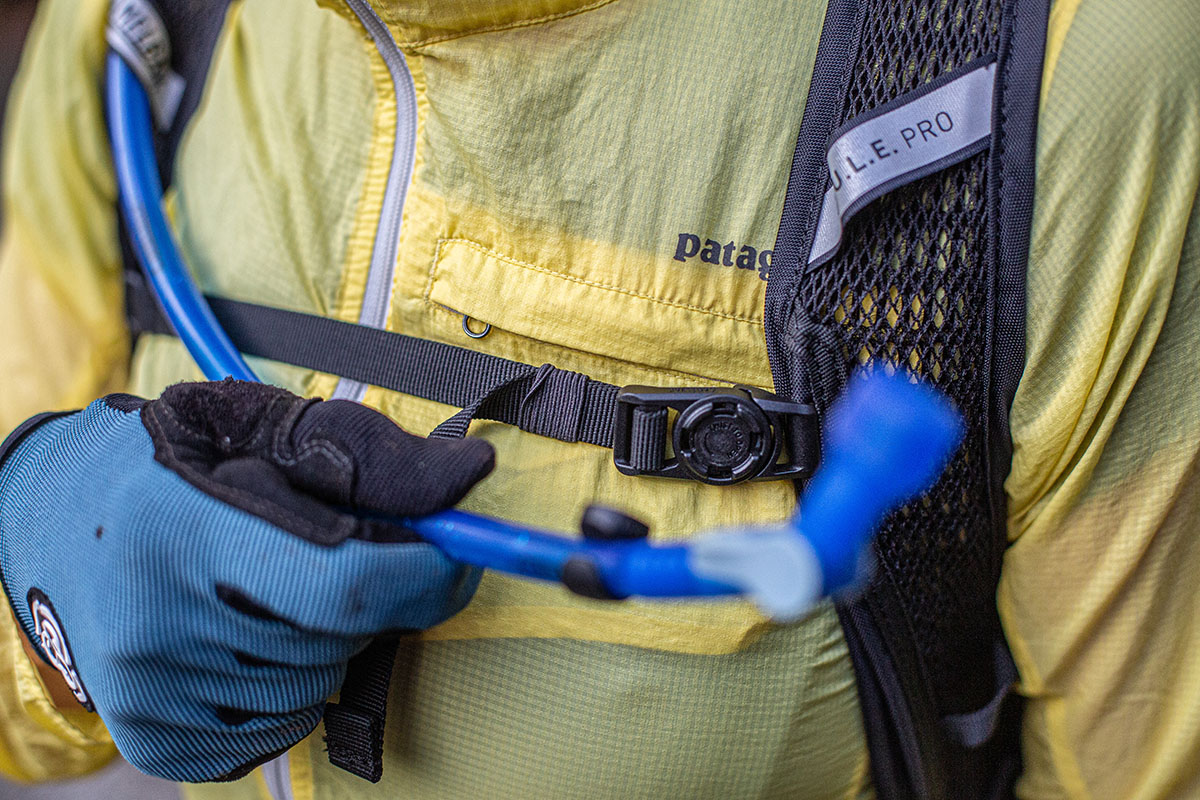
Reservoir Shape and Placement
Water is heavy and prone to leaking, so the location of your reservoir is a detail that shouldn’t be overlooked. Some packs, like the Patagonia Dirt Roamer, house the reservoir in a separate compartment to ensure it’s protected from sharp equipment (and to help keep your gear dry if it leaks). Others have a sleeve inside the main compartment with a clip for suspending the reservoir to keep it from slipping downward as it empties.
There are also differences in bladder positioning: Some packs have vertically oriented pockets, so the reservoir lays flush against your back, while others (like the Dakine Seeker 18L) position the bladder low on the lumbar spine. This will largely come down to what feels most comfortable for you, but we’ve found the low reservoir placement to be great in terms of overall stability. Finally, it’s important to note that some bladders are specifically designed to fit in their respective pockets, meaning they can’t be transferred between packs.
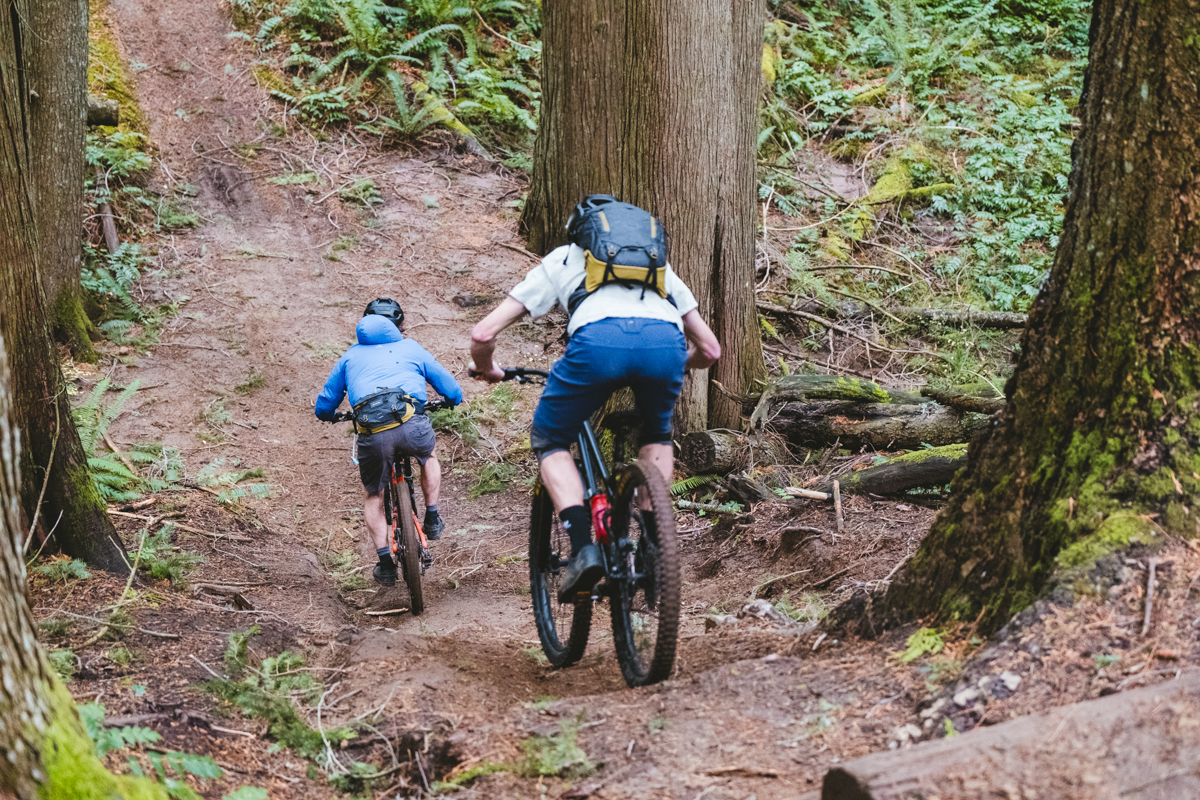
Helmet Attachment
A dedicated helmet attachment system is nice if you’re looking to stow your lid during an uphill car shuttle, on a hike-a-bike section of trail, or grabbing a bite après-ride. Some riders also carry their bike helmet on their pack during long climbs on forest service roads, particularly in hot conditions. Depending on your use of the feature, this could be an important consideration or inconsequential (we land on the former). But few things scream “gaper” more than a helmet dangling by its chin strap, bouncing and clanking around as you walk into the brewery after your ride. If you anticipate using a helmet carrying system, designs range from quite simple to fairly sophisticated (like the chin strap slot on the CamelBak Mule Pro). Our favorite is Osprey’s LidLock system, which is essentially a well-laced bungee strap with a rigid plastic plate to secure the helmet in place. And a final note: Hip packs omit helmet attachment systems due to their small size, which may or may not be a dealbreaker depending on your priorities.
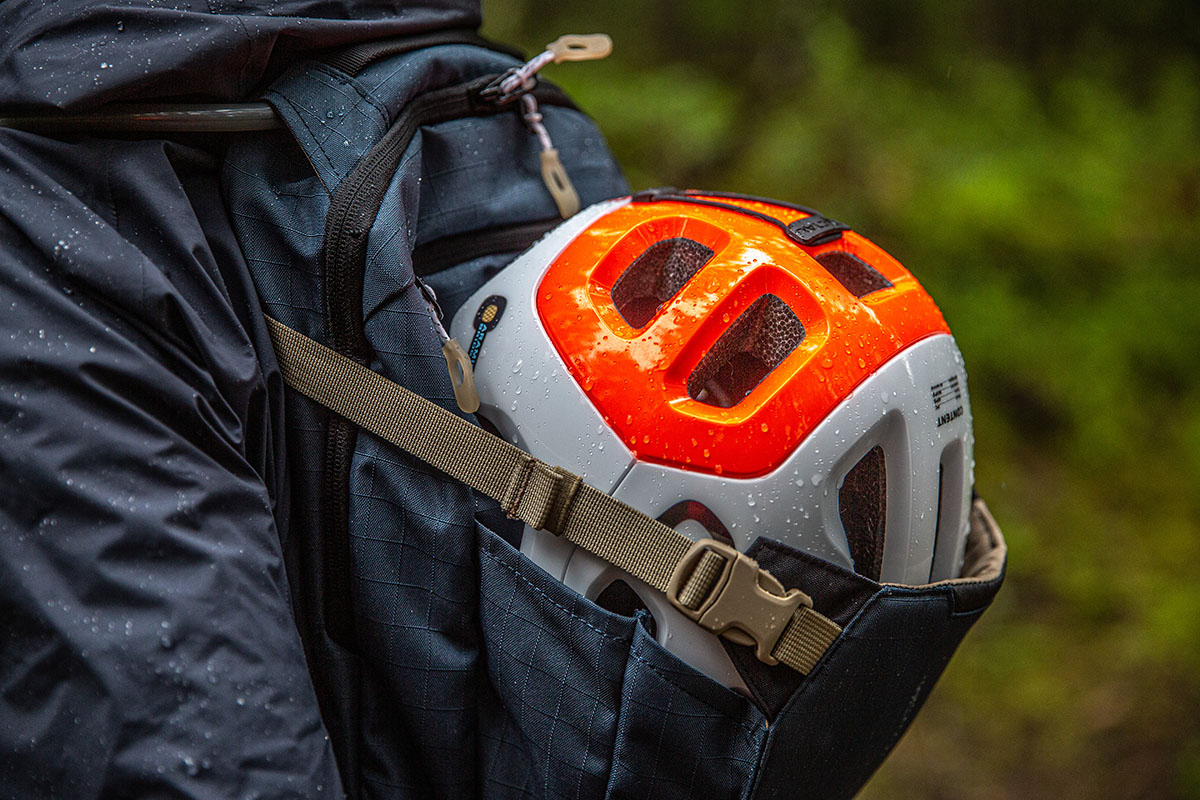
Integrated Back Protection
Riders pushing their limits and learning new tricks may benefit from a pack that incorporates back protection, like the Evoc Trail Pro and POC Column VPD Backpack Vest. How it works: An impact-absorbing panel at the back safeguards your spine against rocks and other sharp objects that could cause damage during an unintentional spill while also preventing it from overextending. Importantly, there are two levels of protection available, and the Evoc and POC packs above boast level 2 protection (EN 1621-2), which meets the highest standard for impact absorption in the event of a crash. A couple other models—namely, the CamelBak Mule Pro—meet the same standard if you purchase their respective back protectors separately.
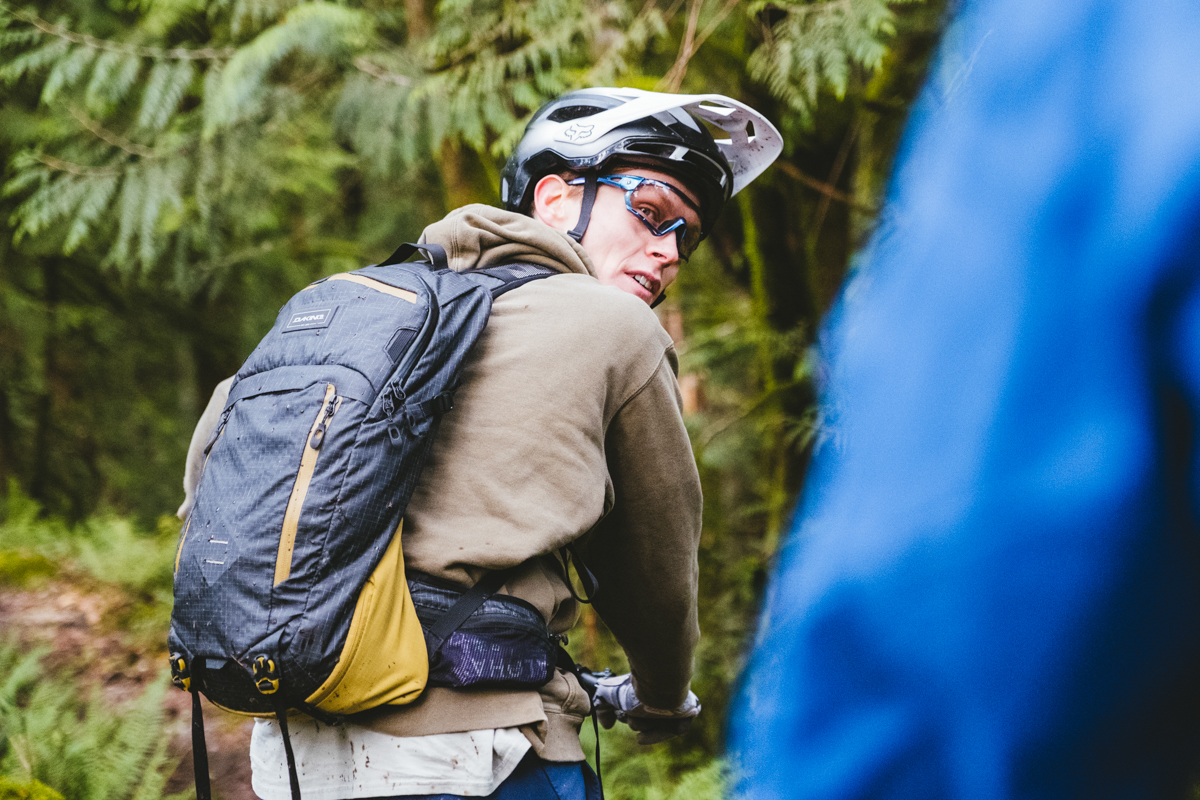
In terms of downsides, protector panels inevitably add weight and bulk, but the good news is that they’re removable for less demanding rides. This also means they’re easy to replace—like a mountain bike helmet, a back protector’s integrity is compromised once impacted, and we highly recommend purchasing a new panel after a crash. Of note: Evoc will evaluate any of their protectors’ integrity and send a replacement for free if it’s been damaged.
Friction points are inevitable during long days in the saddle, and it’s essential that you find a pack that fits. In addition to being more comfortable, a well-fitting pack will also feel more stable while riding. Most designs are only offered in a single size (the Evoc Trail Pro and Patagonia Dirt Roamer are two exceptions), but the good news is that adjustable sternum, waist, and shoulder straps are nearly universal. With the ability to move and adjust the straps, we’ve had no issues sharing a pack among riders of multiple sizes. No two bodies are the same, however, and we highly recommend trying packs on before you buy to ensure you can get a snug (but not restrictive) and comfortable all-around fit.
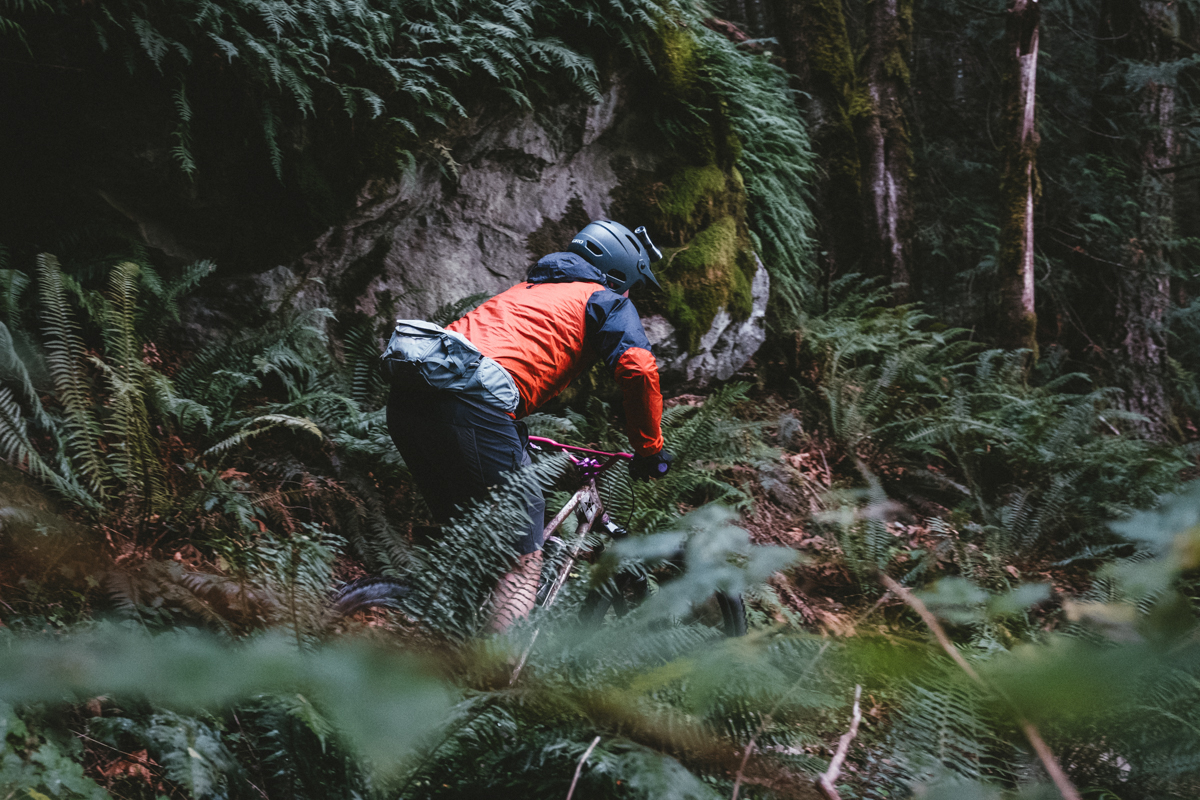
While most of the packs on our list (and on the market) are one-size-fits-all, many do come in a women’s-specific version. However, the differences between men’s and women’s designs are relatively minor. In the case of the Osprey Raptor (men’s version) and Raven (women’s), the Raven has a slightly shorter torso length and comes in different colorways. For the Mule Pro, CamelBak states that the women’s model has a different fit and shape than the men’s version, including a more contoured shoulder harness. In the end, we recommend going with whichever model fits and feels best—regardless of the labeling.
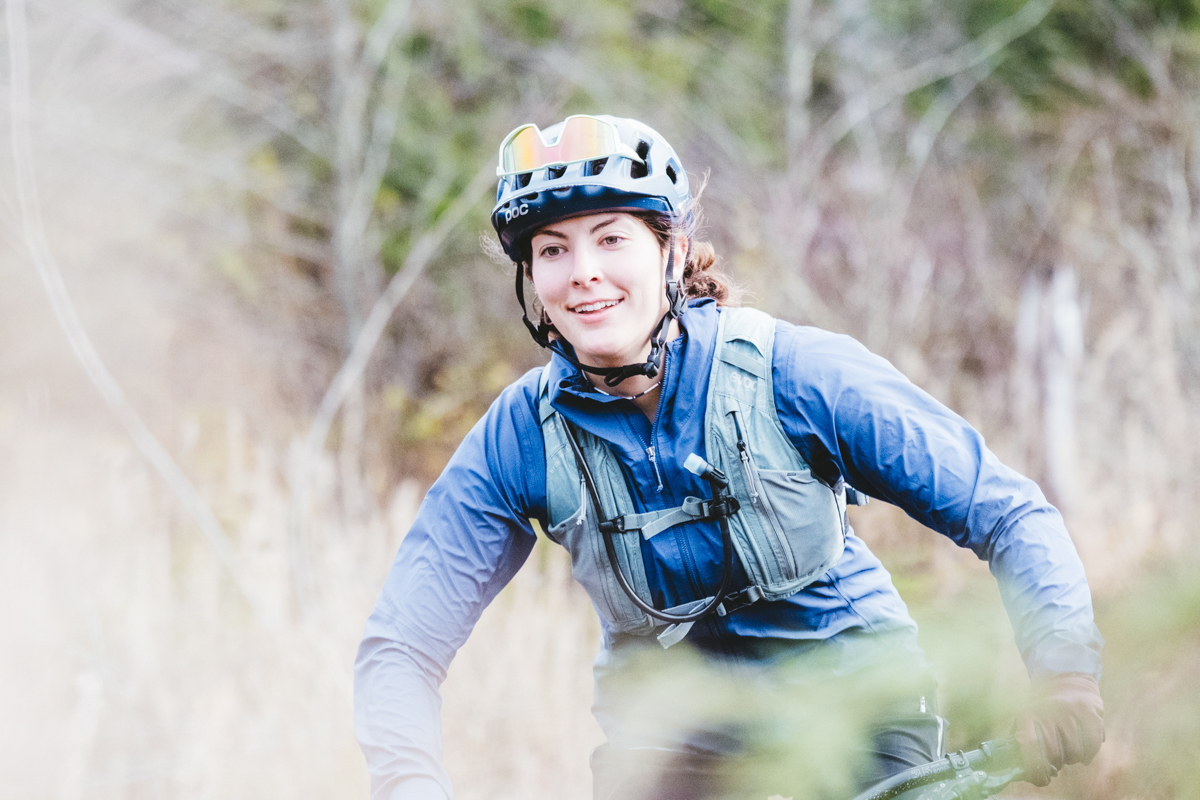
Since mountain biking is a highly aerobic and often sweaty sport, breathability is a top consideration for many riders. And while many of the packs we tested advertise ventilated backpanels and sweat-wicking technology, overall performance varies quite a bit—striking a good balance between a snug fit and maximum airflow is no small feat. The Patagonia Dirt Roamer 20L, for example, sits close to the back and doesn’t rank highly in terms of overall ventilation. Conversely, the mesh backpanels on the CamelBak Mule Pro, Dakine Seeker 18L, and Osprey Raptor/Raven are positioned farther away from the body (or have offsetting to padding to create some space), allowing air to flow between your back and the pack. We called out any notable outliers—on both sides of the spectrum—in the write-ups above, but if you tend to run warm or prefer long, hard days in the saddle, you’ll likely want to opt for a suspended mesh design (like in the Dakine Seeker 18L) over a close-fitting backpanel.
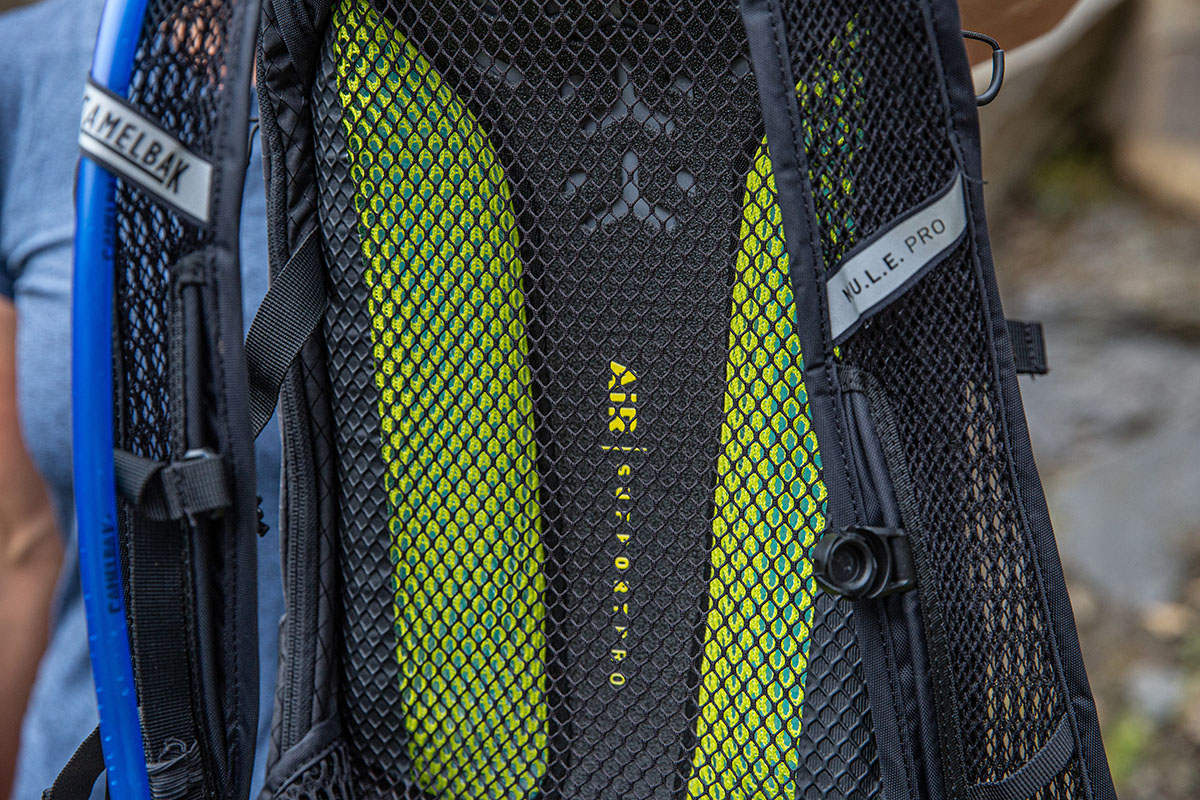
Pack weight is dependent on multiple factors, including capacity, fabric thickness, and number of features—among others. On our list above, the lightest option is the Evoc Hydro Pro 3 at a scant 8.8 ounces, while the heaviest is Dakine Seeker 18L at just under 2 pounds. While that’s a relatively small range, it’s important to consider what you’re getting for the added heft. In the case of the Dakine Seeker, that means thick fabrics that hold up well to long-term use, a myriad of internal and external pockets, and exterior straps for accommodating bulky items like knee pads. By contrast, the Hydro Pro 3 is decidedly minimalist with its streamlined coverage, flimsier build, and limited feature set.
A final consideration is the weight of your typical load—stuffing the lightweight Hydro Pro 3 with an SLR camera and extensive toolkit (if capacity permits) would likely make for a bouncy, unwieldy ride. If you’re partial to long days in the saddle that require a lot of gear, we’d recommend going with a burlier (i.e., heavier) pack. From our experience, the most balanced designs land in the 1- to 2-pound range.
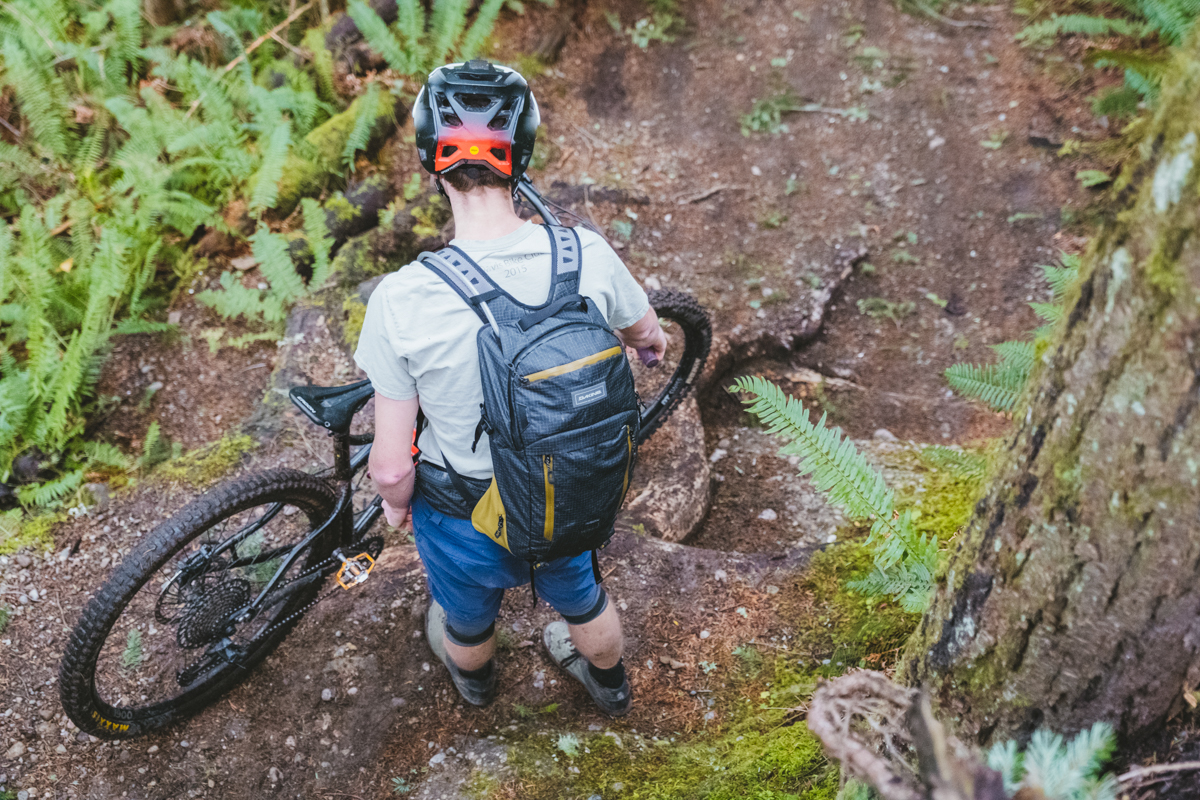
Given the inherently rough nature of mountain biking, the packs above are all designed to withstand considerable use and abuse. However, some are better equipped for the job than others. Fabric denier is a common measurement of fabric thickness, and we've included the listings for the pack body when available in the table above. Materials like heavy-duty nylon (often 200-denier and up) as well as strong, waterproof zippers are good indicators of overall durability. While none of the packs above threatened to unravel at the seams during testing, there were a few that stood out in terms of all-out toughness and build quality, including the Evoc Trail Pro and Dakine Seeker 18L—the two heaviest designs on our list, which is no coincidence.
Back to Our Top Mountain Bike Pack Picks Back to Our MTB Pack Comparison Table